
- Lifestyle Essentials
- Cases & Straps
- All Chargers
- Popular Chargers
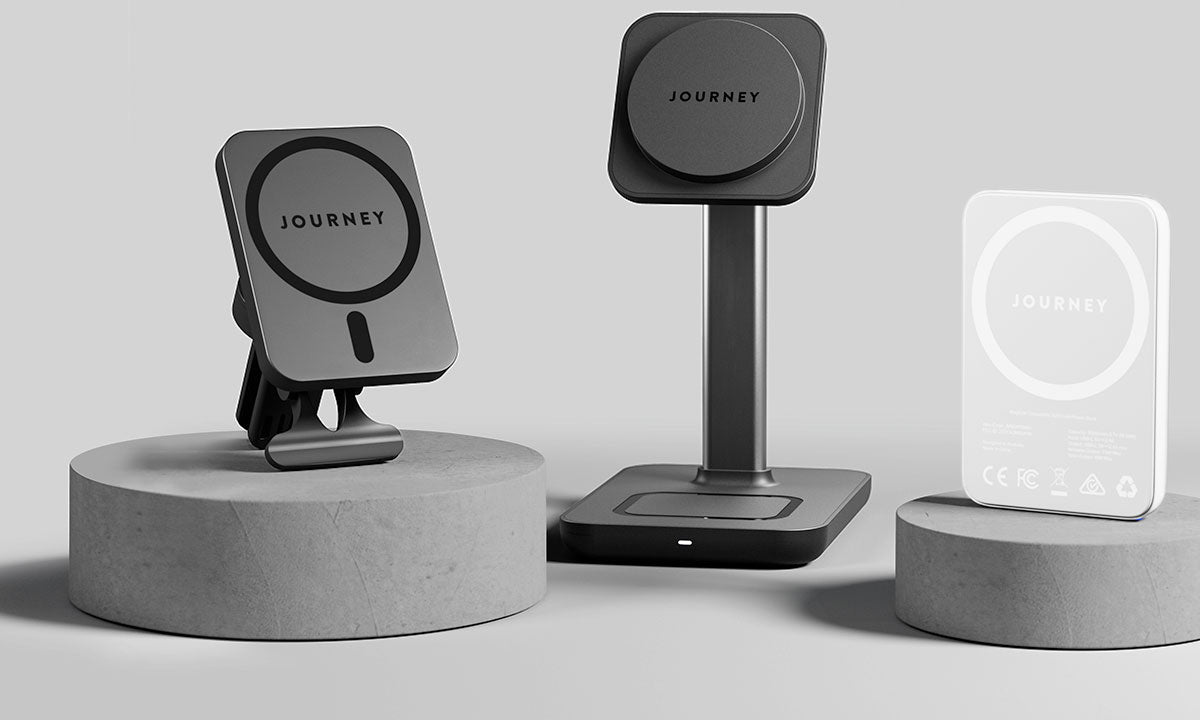
- Wireless Chargers

- Wall Chargers
- Laptop Sleeves
- Loc8 Finder Tags

NEXA Laptop Sleeve

ALTI Deskmats

- iPhone Cases
- AirPods Cases
- Apple Watch Straps

All Products

- The Journey Blog
- Charging Stations
- Car Chargers
- Power Banks
- Accessories
- TRIO Charging Station
- EXPRESS Car Charger
- BLITZ 65 USB-C Charger
- EZMO MagSafe Wallet
- LOC8 MagSafe Wallet
- LOC8 Passport Wallet
- NEXA 4-in-1 Laptop Sleeve
- LOC8 Finder Card
- LOC8 Finder Fob
- AirPods Pro (Gen 2)
- AirPods (Gen3)
- Apple Watch 42-45mm
- Refund Policy
- Shipping Policy
- Journey Affiliate Program
Your cart is empty
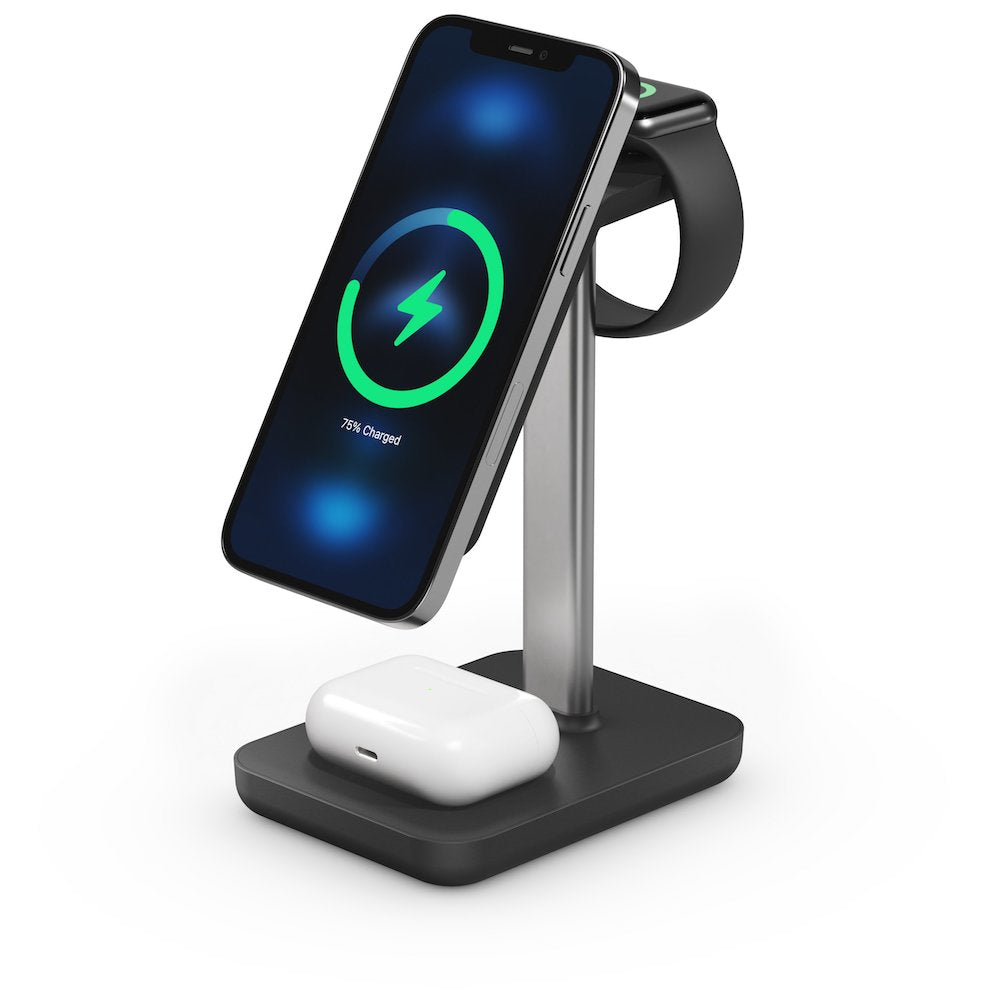
3 in 1 Wireless Charging Station
🩷 Mother's Day Sale now on | use code: GIFT20

Express Shipping Nationwide

Money Back Guarantee
Charge all three of your Apple devices, iPhone 14/13/12, Apple Watch & AirPods together with Journey's 3-in-1 Wireless Charging Station.

No more messy charging cables.
Quickly remove all the cords hanging around your nightstands, working desks, or living room end tables.
NO MORE MESSY CABLES!
Charge 3 devices wirelessly..
Charge all three of your Apple devices, iPhone Apple Watch & AirPods together.
Compatible with : iPhone 12 /13/14/15, Apple Watch (Series 3-9/SE/Ultra 1/2) and Airpods (All wireless charging enabled models)
KEEP THE WATCH TOPPED UP
In built apple watch charger..
Compatible Apple Watch models: Series 3-9/SE/Ultra 1/2.
BATTERY LIFE LONGEVITY
Keeps the battery healthy while charging fast..
With over-current, over-voltage and over-temperature protection the charger can prevent over-charging your device's battery. Our latest charging technology charges your phone 2x more efficiently than other chargers in the safest possible way.
SUBTLE LED INDICATOR
Designed for uninterrupted sleep..
Unlike other 3 in 1 chargers, we prioritise your experience more than anything else. The light is designed to face upward and just enough to let you know your items are being charged.
Snap it. Charge it. Enjoy it.
Use your phone the way you want. Mount it at a slight angle for the best experience in both portrait and landscape modes.
Anti-slip , Weighted base.
Put this charger anywhere you like - your desk, next to your bed, your living room and simply place all your Apple devices to charge wirelessly! Weighted design allows for easy one handed pick up.
EASY TO USE
Step 1: Unbox the Charging Station
Step 2: Connect to Power
Step 3: Ready to Use
Specifications
- Dimensions - 163.3mm (H) x 113.1mm (D) x 85.6mm (W)
- MagSafe Compatible - Yes
- Weight- 325 g
- Package Contains- 3 in 1 Wireless Charging Station, USB-C Charging Cable, User Manual ( Doesn't include wall charger)
- Specially created for iPhone 15, 14, 13 and 12 series iPhones. Will not work with iPhone 11 and older models
- Strong magnetic hold that auto aligns and holds your phone in place
- Compatible case for iPhone 15, 14, 13 and 12 series iPhones. If a case is used on the phone, it must support MagSafe compatibility.
- Charges all 3 devices (iPhone 15/14/13/12; Apple Watch Series: 3-9, SE & Ultra 1/2; AirPods - Wireless Charging Models)at once- no extra cables required
- Easily mount your iPhone in portrait or landscape mode while charging
Q: Does this work with Android phones?
A: No, this charger is especially made for MagSafe compatible devices (iPhone 15, 14, 13 & 12 series) and MagSafe cases. It does not work with Android phones.
Q: Does it work well with all 3 devices being charged together?
A: It will work perfectly fine if you put all 3 devices on it. With the latest technology, it can fast charge all 3 devices at the same time.
Q: Does it work with a phone case?
A: Works with MagSafe compatible cases. It can also be used without a case.
Q: Will it work with iPhone 14?
A: Its designed to work perfectly with iPhone 12 series and above.
Q: Does the magnet have any side effect on my phone?
A: No, the latest smartphones and accessories are not affected by magnets and smartphones like iPhone 15, 14, 13 & 12 have magnets inside them.
Q: I have used other 3-in-1 chargers before and the Apple Watch charging speed was pretty slow. Will this be different?
A: This charger will charge your Apple Watch at standard charging speed. (To be used with a wall charger with a minimum output of 18W for best performance.)
Q: Will it work with the latest Apple Watch series 8 and Ultra?
A: Yes, it works with Apple watch series 3-9, SE and Ultra 1/2.
Q: Can I use that with my AirPods Pro?
A: Yes, it works with the AirPods Pro and all other AirPods models which support wireless charging
Q: How bright is the light on the charger at night?
A: The design of the charger includes a small light indicator to let you know the charging status. The light is not obstructive and is most suitable for nighttime charging.
Q: I use a 15 Watt adapter to charge my phone, can I use the same adapter for this?
A: We recommend using an 18 Watts or above adapter for efficient power delivery.
THE JOURNEY PROMISE

U.S.A. BASED
The best local support
Our USA based offices and warehouses ensure the fastest support for all of our US customers.

U.S.A. SHIPPING
Fast & local shipping
Our USA based warehouses ensure that your package arrives at your doorstep as quickly as possible.
This product is rated 4.9 of 5.0 stars. It has received 811 reviews.
Customer Reviews
Everything in one place. Easy and awesome.
The phone sits on the stand and you can read recipes and emails - hands free, it’s great!
Great product
It’s the best Christmas gift I got this year. Customer service is amazing. I’ll go back.

Nerd Journey
A Podcast to Help the Technology Professional Accelerate Career Progression, Increase Job Satisfaction, and Be more Effective in Their Current Role

Nerd Journey 037: Jon Hildebrand and the Journey to Architectural Thinking
Podcast: Play in new window | Download
Subscribe: Apple Podcasts | Spotify | TuneIn | RSS | More
Welcome to episode 37 of the Nerd Journey Podcast [ @NerdJourney ]! We’re John White ( @vJourneyman ) and Nick Korte ( @NetworkNerd_ ), two VMware Solution Engineers who are hoping to bring you the IT career advice that we wish we’d been given earlier in our careers. In today’s episode we discuss.
Original Recording Date: 05-06-2019
Topics – Jon Hildebrand
2:26 – jon’s background and career journey, the cerner years.
- Today Jon is a Principal Technologist at Cohesity and is located in Kansas City.
- Jon realized early on that networking would be very important in his career.
- Jon was part of the IT staff at the college he attended and landed a job at Cerner along with several classmates. His first role was that of a consultant.
- How is working with college professors similar to working with seasoned IT professionals? List to Jon’s take on that.
- One of Jon’s major projects was tackling a Citrix environment in the early 2000s. This was a 6-year endeavor and required heavy travel.
- Jon then moved over to managing internal systems (VMware and others) to broaden the technology focus.
- By the time he was close to finishing up at Cerner, he was part of a 4-5 person team that managed 80,000 to 100,000 virtual machines and 2500 – 3000 hosts.
- The scale of the environment required learning automation skills, and Jon started exploring PowerShell and PowerCLI , drawing on a background in software engineering.
- He started to really enjoy presenting and realized he did not enjoy what he was doing at his day job.
- Someone he knew from school let him know about a new opening at a service provider.
12:46 – Moving to LightEdge Solutions
- This role would expose Jon to learning networking, storage, and managing multiple global datacenters (not just a single datacenter).
- Something as simple as building a server could change hands 8 times. Jon was able to trim some of these processes like building a virtual machine down from weeks to just a few minutes.
- The automation bug never really left Jon, and even now, he’s still into PowerShell.
- Jon speaks to other reasons for leaving Cerner in this light.
- One of the reasons this transition was easy for him to make was his ability to improve processes.
- John White weighs in on his experience with organizational structure.
- Beware of "that’s how we’ve always done it" in interviews.
- What other red flags does Jon recommend you look for when interviewing?
- Contact Jon Hildebrand on Twitter @snoopj123 .
Contact us if you need help on the journey.
Leave a reply cancel reply.
Your email address will not be published. Required fields are marked *
Notify me of follow-up comments by email.
Notify me of new posts by email.

- Screenshots / Journey
Welcome To Deep Messiah’s Podcast. A Podcast With A Sole Purpose Of Shining Light On Underground House Music And Spinners.
Deep Messiah’s Podcast Deep Messiah
- APR 29, 2024
Messianic Scripture Written By Deep Messiah (2024)
Follow Us On Twitter @Messiahspodcast @Deep_Messiah
- APR 11, 2024
Messianic Scripture Written By Mack Da DJ (2024)
- MAR 29, 2024
Messianic Scripture Written By De_-Wolf (2024)
- MAR 7, 2024
Messianic Scripture Written By Deep Messiah Pt.2 (2024)
- FEB 25, 2024
- © 2024 Deep Messiah’s Podcast
Top Podcasts In Music
You might also like.

Sorry, we couldn’t find the page you were looking for.
We will keep fighting for all libraries - stand with us!
Internet Archive Audio

- This Just In
- Grateful Dead
- Old Time Radio
- 78 RPMs and Cylinder Recordings
- Audio Books & Poetry
- Computers, Technology and Science
- Music, Arts & Culture
- News & Public Affairs
- Spirituality & Religion
- Radio News Archive

- Flickr Commons
- Occupy Wall Street Flickr
- NASA Images
- Solar System Collection
- Ames Research Center

- All Software
- Old School Emulation
- MS-DOS Games
- Historical Software
- Classic PC Games
- Software Library
- Kodi Archive and Support File
- Vintage Software
- CD-ROM Software
- CD-ROM Software Library
- Software Sites
- Tucows Software Library
- Shareware CD-ROMs
- Software Capsules Compilation
- CD-ROM Images
- ZX Spectrum
- DOOM Level CD

- Smithsonian Libraries
- FEDLINK (US)
- Lincoln Collection
- American Libraries
- Canadian Libraries
- Universal Library
- Project Gutenberg
- Children's Library
- Biodiversity Heritage Library
- Books by Language
- Additional Collections

- Prelinger Archives
- Democracy Now!
- Occupy Wall Street
- TV NSA Clip Library
- Animation & Cartoons
- Arts & Music
- Computers & Technology
- Cultural & Academic Films
- Ephemeral Films
- Sports Videos
- Videogame Videos
- Youth Media
Search the history of over 866 billion web pages on the Internet.
Mobile Apps
- Wayback Machine (iOS)
- Wayback Machine (Android)
Browser Extensions
Archive-it subscription.
- Explore the Collections
- Build Collections
Save Page Now
Capture a web page as it appears now for use as a trusted citation in the future.
Please enter a valid web address
- Donate Donate icon An illustration of a heart shape
CTJ 037 Lingo with Jeffrey Shaw
Audio with external links item preview.

Share or Embed This Item
Flag this item for.
- Graphic Violence
- Explicit Sexual Content
- Hate Speech
- Misinformation/Disinformation
- Marketing/Phishing/Advertising
- Misleading/Inaccurate/Missing Metadata
This material may be protected by copyright law (Title 17 U.S. Code).
plus-circle Add Review comment Reviews
Download options, in collections.
Uploaded by arkiver2 on April 24, 2019
SIMILAR ITEMS (based on metadata)
Navigation Menu
Search code, repositories, users, issues, pull requests..., provide feedback.
We read every piece of feedback, and take your input very seriously.
Saved searches
Use saved searches to filter your results more quickly.
To see all available qualifiers, see our documentation .
- Notifications
Join the LD community, Click here to register
Journey : American Tour '83 - Frontiers... And Beyond (1983) [ T E - D 0 3 7 ]
ดูหนังออนไลน์ฟรี 2023 หนังใหม่ชนโรง ดูหนังฟรีออนไลน์ 037 HD
Journey 2: The Mysterious Island (2012)
ตัวอย่างหนัง : journey 2: the mysterious island (2012).

ในภาคต่อของหนังฮิต Journey to the Center of the Earth ฌอน เด็กหนุ่มวัย 17 ปี (จอช ฮัทเชอร์สัน กลับมาในบทเดิมจากภาคแรก) ได้รับสัญญาณขอความช่วยเหลือจากเกาะลึกลับที่เต็มไปด้วยสิ่งมีชีวิตสุดพิสดารและอันตราย ภูเขาไฟพร้อมปะทุ และความลับสุดอัศจรรย์! แต่เมื่อความตั้งใจของฌอนไม่อาจยับยั้งได้ พ่อเลี้ยงของเขา (ดเวย์น จอห์นสัน) จึงต้องเดินทางไปด้วย โดยมีนักขับเฮลิคอปเตอร์ (หลุยส์ กัซแมน) และลูกสาวหัวรั้น (วาเนสซ่า ฮัดเจนส์) มุ่งหน้าสู่เกาะมหัศจรรย์เพื่อช่วยเหลือมนุษย์คนเดียวที่อยู่ที่นั่น ก่อนที่แผ่นดินไหวจะฝังขุมสมบัติบนเกาะแห่งนั้นไปตลอดกาล

หนังที่เกี่ยวข้อง

Dr. Brain (2021)

In The Shadow of The Moon (2019)

Barbershop (2002)

Finding Michael

Happy Old Year

Glass Onion: A Knives Out Mystery

The Dude in Me (2019)

The Journey of a Lifetime
Why make a blog.
Published by
I officially found out about my diagnoses back in October. It was a heavy pill to swallow, so I made the decision to act as though I was not given this information and move on with my life as usual. Then, in January, I lost my job and I found…
Therapy Homework
I love therapy homework. I guess I’m like Hermione in that way. I mean, who likes homework? (I do). My guess is that I leveled up in therapy and my therapist knows it. I have been keeping lists on my phone to keep reminded of what’s helpful to me etc.…
The Art of Connection

In the ever-evolving world, the art of forging genuine connections remains timeless. Whether it’s with colleagues, clients, or partners, establishing a genuine rapport paves the way for collaborative success.

Beyond the Obstacle

Challenges in business are a given, but it’s our response to them that defines our trajectory. Looking beyond the immediate obstacle, there lies a realm of opportunity and learning.
Growth Unlocked

Every business has a unique potential waiting to be tapped. Recognizing the keys to unlock this growth can set an enterprise on the path to unprecedented success.
Collaboration Magic

The magic that emerges from effective collaboration is undeniable. When diverse minds converge with a shared purpose, the results can be transformative.
I’m Allie
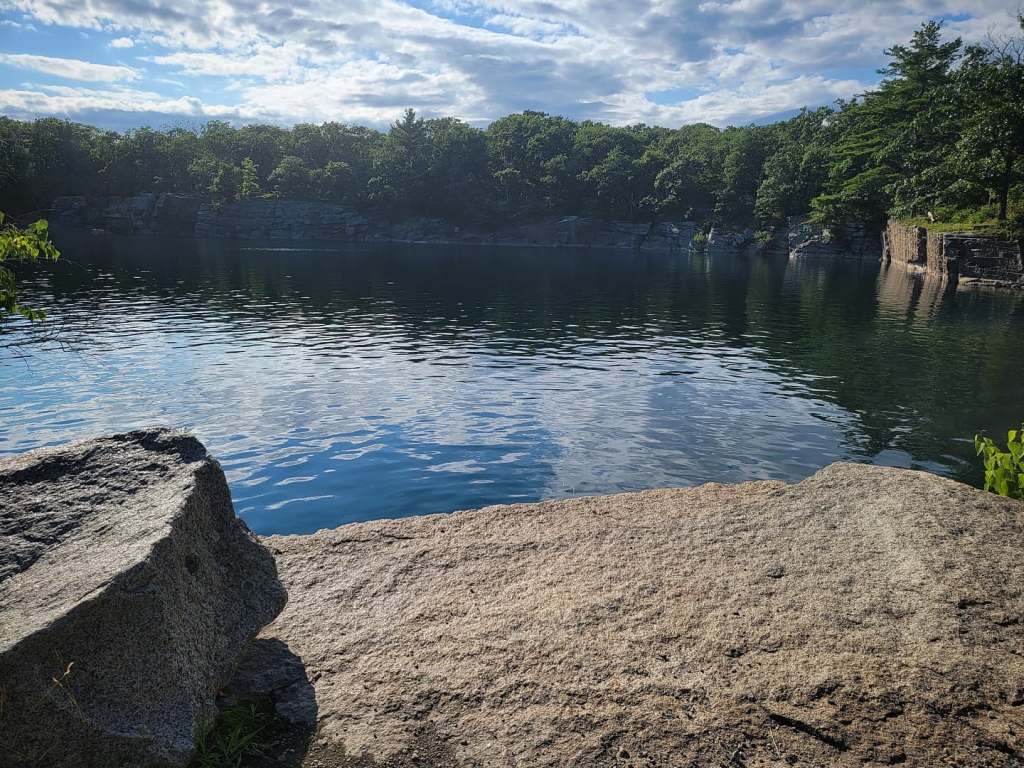
Welcome to my documented journey about finding out what is actually causing some thoughts, behaviors, and emotions. I had thought I had a pretty good idea of myself and why I am the way I am. That is until I started diving into new diagnoses. I hope in your time here, you find solace, knowledge, understanding, and most of all, comfort in knowing you’re not alone.
- Uncategorized
Alexithymia anxiety Autism C-PTSD depression Diagnosis Emotions mental-health Progress Suicidality Therapy Therapy homework writing
Helpful Resources (Coming Soon!!)

- Already have a WordPress.com account? Log in now.
- Subscribe Subscribed
- Report this content
- View site in Reader
- Manage subscriptions
- Collapse this bar
Share this via Facebook Share this via X Share this via WhatsApp Share this via Email Other ways to share Share this via LinkedIn Share this via Reddit Share this via Telegram Share this via Printer
Download the full report in English
“We Couldn’t Wait”
Digital Metering at the US-Mexico Border
A man seeking asylum in the US uses his phone to access the US Customs and Border Protection CBP One application to request an appointment at a land port of entry to the US, outside a shelter in Ciudad Juarez, Mexico, January 12, 2023. © 2023 REUTERS/Jose Luis Gonzalez
When Sandra S., her husband, and their two young children arrived at the US-Mexico border, they thought they had reached safety.
They had fled Michoacán, Mexico, after an armed member of a cartel forced his way into their home and threatened to kill the family if they did not keep quiet about having witnessed the disappearances of several people at the neighboring cartel-owned property. The family said the property functioned as a stash house—a place where cartels keep kidnapped or trafficked people, money, weapons, or drugs.
Sandra and her husband left in the early morning, pulling their children out of school without notice, and made their way to Nuevo Laredo, Mexico, which borders Laredo, Texas, in the United States.
When they reached the international bridge, US Customs and Border Protection (CBP) officers standing at the border demarcation line between the US and Mexico refused to admit the family, instructing them that they first needed to make an asylum appointment via CBP One, a US government mobile application. The app also has an online portal. Human Rights Watch accompanied the family when they tried for a second time to seek asylum, and CBP officers again turned the family back, even after being made aware that the family was Mexican and feared persecution in Mexico. Operatives of a different cartel working the border in Nuevo Laredo had already recognized the family as being Mexican asylum seekers trying to flee Mexico and threatened them with violence if they failed to “keep quiet.” Sandra said that if the cartel learned why they had fled, its members would hurt them.
Upon returning to Nuevo Laredo, the family’s only practical option was to wait in a makeshift encampment near the international bridge along with hundreds of other asylum seekers, some of whom had been waiting for an appointment for up to four months. During these waits, asylum seekers and migrants face violence and other dangers as well as a lack of adequate food, clean water, and other necessities. Unable to return home or enter the United States without an appointment booked via the CBP One application, asylum seekers are often effectively trapped at the border for long periods of time. Many stay in encampments or shelters where they are easy targets for criminal groups.
The fundamental right of all people to seek asylum in another country, and to be granted refugee protection after proving fear of persecution on specific grounds, is provided for in US law and in international law binding on the United States. While the right to seek asylum is guaranteed under US law, changes in administrative regulations and US policy in recent years have substantially curtailed people’s ability to access this right in practice.
Tens of thousands of people who, like Sandra and her family, are seeking asylum in the United States have been forced to wait in Mexico under a new rule introduced by the administration of US President Joe Biden in May 2023. The Biden asylum rule impermissibly limits the right to seek asylum for many people and compels them to wait in foreseeably dangerous and inhumane conditions in Mexico.
The Biden asylum rule effectively establishes two categories of asylum seekers. It privileges one of these groups, those who can schedule an appointment on the CBP One app and then appear at the time of their appointment at an official border crossing, or “port of entry.” The second, non-privileged group—all other asylum seekers without visas or another basis for entering the United States—must show they fit within one of a handful of narrow exceptions that allow them access to the regular US asylum system.
Crucially, everyone in the second, non-privileged group—including anyone arriving at a port of entry or apprehended immediately after entering the United States irregularly—is presumed ineligible for asylum. They also may be subject to detention in abusive conditions in immigration holding cells at the border—sometimes for weeks—and processed for removal under “enhanced” expedited removal rules, rushed procedures that do not afford adequate due process. People who attempt to return to the United States within five years after deportation may face criminal prosecution. Substantively, the Biden asylum rule is nearly identical to two Trump-era policies held by federal courts to be illegal.
The near-mandatory nature of the CBP One app, strict limits on the number of asylum seekers who can access US ports of entry each day, and other restrictions imposed by the Biden asylum rule have drastically narrowed access to asylum. The result is a system of “digital metering” at the US-Mexico border.
CBP’s nearly exclusive use of the CBP One app and portal to process asylum seekers creates additional barriers to access for those seeking asylum, particularly for certain groups . Many asylum seekers do not have cellphones at all, usually because they cannot afford them or because criminal actors or government agents in Mexico have stolen their phones. When asylum seekers do have phones, their devices often do not have memory space to support the app, they cannot pay for the data they need to use the app, and they do not have access to Wi-Fi.
Some asylum seekers Human Rights Watch interviewed for this report were not aware of the existence of the CBP One app; most knew about it but had problems using it. Nearly all of those we spoke with for this report described having trouble using CBP One, often due to factors such as their race, digital literacy, ability to read or write, language, age, or disability.
While the US government says that having a CBP One appointment is not required for asylum seekers to be processed by CBP officials, this report finds that the app is effectively mandatory because people are turned away by US and Mexican officials at the border when they do not have an appointment on the app and because the US subjects asylum seekers who cannot or do not get appointments on the app to punitive expedited removal procedures.
The US government claims that “scheduling appointments makes the process safer and more orderly, and the advance information that is submitted to CBP officers creates a more efficient and streamlined process for CBP and for individuals.” However, in this report Human Rights Watch demonstrates that the reality is often far from this vision of streamlined efficiency.
The very limited number of appointments available via CBP One fails to meet asylum processing needs, which CBP and Department of Homeland Security (DHS) officials have said reflects CBP’s limited capacity. Capacity, though, largely reflects the administration’s priorities and choices. The US government has significant resources at its disposal to increase humane processing capacity, but it has created a vicious cycle whereby increased numbers of asylum seekers are forced into labor-intensive expedited processes overseen by CBP instead of fair and efficient asylum determination procedures, accessible to all as required under US law.
Biden administration officials can argue their policies are an improvement over what could be an even worse US approach at the border. The administration has established a new humanitarian parole program to allow more asylum seekers safe pathways into the US, though they are limited to certain nationalities, and among them, people who can afford to pay for plane tickets and other travel, are able to obtain passports, and have family members in the United States wealthy enough to apply to sponsor them with the US government. The Biden administration has also made extensive use of temporary protected status and raised refugee admissions caps.
Still, the Biden asylum rule and digital metering policies are part of a larger effort by the United States to deter irregular migration at the US-Mexico border. The US has sought agreements with many Latin American governments, including Mexico and Guatemala, aimed at deterring migration. In one such arrangement, Mexican President Andrés Manuel López Obrador has agreed to accept some non-Mexican asylum seekers who are rapidly removed or returned “voluntarily” by the United States.
Against this high-level backdrop, officials from both the United States and Mexico participate in blocking asylum seekers from seeking asylum in the United States. In this report, Human Rights Watch documents efforts by the US and Mexico to conduct “turnbacks”—blocking people from entering the United States and pushing them back to Mexico—of asylum seekers at ports of entry at the US-Mexico border. The US CBP One appointment system is cited by officials of both governments when blocking asylum seekers from accessing the border. Turnbacks today are therefore often the dangerous result of digital metering and the Biden asylum rule.
The US policies blocking asylum at the border in recent years, carried out in collaboration with Mexico, have changed in name and severity, but one material outcome for asylum seekers has remained the same: they are forced to wait in northern Mexican states, as well as in many cities in other parts of Mexico through which migrants transit, where they are systematically targeted by cartels, sometimes with the help of Mexican government officials, for kidnapping, extortion, sexual assault, robbery, and other abuse. Digital metering feeds cartel needs for a vulnerable population to prey upon.
The more difficult it is for migrants to cross the US-Mexico border, the more money cartels make, whether from smuggling operations or from kidnapping and extortion. Human Rights Watch documented cases of kidnapping for ransom in interviews in each of the five Mexican cities in which we visited for this report. Criminal actors and government officials also have near impunity when sexually assaulting asylum seekers, given the fear and power imbalance they can exploit due to digital metering.
The Mexican government also apprehends many non-Mexican asylum seekers at the US border before they can reach the United States and relocates them to southern Mexico, where they are typically forced to sign a document agreeing to leave Mexico via its southern border. The Mexican government also summarily deports asylum seekers directly to their country of origin.
Similarly, the Guatemalan government has recently agreed in talks with the US government to try to reduce the number of migrants arriving at the US southern border. Asylum seekers told us that police and immigration authorities in Guatemala often conduct invasive searches of their persons and belongings, probing with ungloved hands into shoes, socks, waistbands, bras, and underwear. Some asylum seekers said women had been sexually assaulted during such searches, including acts of unwanted touching by men who identified themselves as Guatemalan government officials.
This report also finds that individual asylum seekers forced by the Biden asylum rule to wait in Mexico often constitute a distinct social group in Mexico—meaning that the rule as applied heightens their need for protection and increases the number of viable asylum claims. Asylum seekers who do not speak Spanish at all or do not speak it as Mexicans speak Spanish are easily identified as non-Mexican. In many cases, asylum seekers from countries other than Mexico are also readily identified by physical appearance, including their facial structure, height, or skin color. These are immutable characteristics of this group—they cannot reasonably change their physical appearance, the languages they speak, or how they speak Spanish. These characteristics set non-Mexican asylum seekers apart, and Mexican society readily recognizes non-Mexican asylum seekers as a distinct social group.
This report also shows that navigating or accessing the Biden asylum rule and the CBP One app is more difficult for certain categories of people—among them, disabled individuals, Black and Indigenous people, people who do not have the language skills, ability to read or write, or digital literacy skills required to use the app, older people, and, for more structural reasons, LGBT people and people who are not wealthy enough to be able to pay for smartphones, data plans, and internet access—or for passports and a financial sponsor in the US. The Biden asylum rule and digital metering system are therefore discriminatory.
Most essential of all, the Biden asylum rule and digital metering violate the fundamental legal principle of nonrefoulement, which prohibits the return of refugees (defined as people with well-founded fears of persecution on specific grounds) to countries where their lives or freedom would be at risk. The principle of nonrefoulement is incorporated into US law and is a cornerstone of international refugee law.
US officials preventing arriving asylum seekers from accessing asylum procedures (which would allow asylum seekers to be identified as refugees or not) based on whether or not they are able to access CBP One appointments likely constitutes refoulement, in violation of international law.
While international refugee law does not formally provide an asylum seeker (a person claiming to be a refugee) the right to enter a country and certainly not a presumptive guarantee that refugee protection will be granted, the refoulement prohibition provides little latitude when the asylum seeker appears at a land border. Summary rejection of asylum seekers at a land border has been found to violate the principle of nonrefoulement by the UN Refugee Agency (UNHCR).
The digital metering system, which includes the effectively mandatory use of the CBP One application enforced by the actions of CBP agents and Mexican officials working in collusion with them, rejects asylum seekers—some of whom may be refugees—at the border. The promise of entry at a later date does not protect against refoulement.
In addition, for people who arrive at the border without a CBP One appointment and are therefore subject to the Biden asylum rule’s enhanced expedited removal procedures, the risk of refoulement is acute. Asylum seekers must now show in credible fear interviews that they are not subject to the Biden asylum rule or that they qualify for one of a few narrow exceptions. The standards set forth in the rule are difficult to meet under the best of circumstances. People who are detained by CBP under abusive conditions and without access to counsel face extraordinary obstacles.
The Biden administration claims that its asylum rule and effectively mandatory use of CBP One will disrupt smuggling networks. Human Rights Watch has observed that, on the contrary, digital metering in Mexico leaves asylum seekers vulnerable to extortion, kidnapping, and violence. And, with no other way to access protection, asylum seekers are more likely to engage smugglers, further enriching criminal cartels.
There is also evidence the new rule is driving people to take greater risks to try to enter the United States undetected. Border deterrence policies have already led to record numbers of border deaths during the Biden administration. During the Trump administration, CBP reported around 300 US-side border deaths each year—an already unconscionable number—but that number skyrocketed in Fiscal Year 2022 (the 12-month period beginning October 1, 2021), the first full year of the Biden administration, when CBP reported more than 850 people found dead in the United States at or near the border in circumstances that suggested they had attempted to enter irregularly. While CBP data for fiscal year 2023 (when the Biden asylum rule went into effect) are not yet public, local medical examiners at the border have already reported new record highs in some regions.
To fulfill US and international legal obligations, the Biden administration should immediately rescind its asylum rule, end all practices of metering, digital or otherwise, and stop collaborating with Mexico and other states to block asylum claims in the United States. The US Congress and the administration should identify and implement approaches that reflect the reality that persecution, conflicts, economic conditions, climate and environmental factors, and peoples’ needs to reunite with family in the United States mean that migration will continue. Lawmakers and policymakers should treat migration as an opportunity on all fronts: reuniting families, fulfilling the promises of protection established by law and engraved on national monuments, and benefiting communities and strengthening society.
The US needs an orderly process for increased opportunities for safe, legal migration—not a digital metering system that increases vulnerability to human rights violations, enriches and empowers cartels, and creates conditions in which it is nearly impossible for asylum seekers and migrants to follow the rules. An orderly process that affords meaningful access to the asylum system is urgently needed. Asylum seekers’ lives are on the line.
Methodology
This report is based on Human Rights Watch interviews with 128 asylum seekers who were able to share information on the experiences of a total of 263 people, including family members and friends with whom they were traveling. Most had been subjected to the CBP One appointment system. Human Rights Watch also interviewed 13 shelter workers, eight migrant service providers, Mexican government officials, and human rights workers.
We conducted interviews in August and September 2023 in Mexico City; Saltillo and Piedras Negras, Coahuila; Monterrey, Nuevo Leon; Nuevo Laredo, Tamaulipas; and Eagle Pass, Texas. Human Rights Watch also observed attempts by asylum seekers to access US ports of entry in Piedras Negras and Nuevo Laredo. Locations were chosen in consultation with other organizations monitoring the impact of CBP One and the Biden asylum rule, including with the International Rescue Committee and Human Rights First. We also observed asylum seekers using CBP One and assessed the app’s accessibility and usability.
Human Rights Watch carried out interviews in English or Spanish, depending on the preference of the interviewee, without interpreters. We informed the interviewees of the purpose of our research, and they consented to be interviewed for that purpose. They did not receive any payments or other incentives. Where appropriate, Human Rights Watch provided migrants and refugees with contact information for organizations offering health care services or legal, social, or counseling services.
The names of migrants and asylum seekers have been replaced with pseudonyms to mitigate security concerns, especially since many of those we spoke with continue to wait in Mexico to seek protection in the United States. Some migrant shelter workers and security guards also spoke to Human Rights Watch on condition of anonymity to mitigate security or funding concerns.
We also shared our findings with both governments on November 3, 2023. We received no response from the United States. We received responses from Mexican government agencies and have included those responses in relevant sections of this report.
Although US law guarantees the right to seek asylum, since at least the mid-1990s successive administrations have narrowed access to asylum, treating claims for protection as burdensome and presumptively abusive. Most recently, in a move that replicates the maneuvers of the Trump administration, the Biden administration introduced a 2023 asylum rule aimed at deterring most arriving asylum seekers.
However, the asylum rule has not deterred people from seeking to enter the United States to seek safety. Nor has it increased the efficiency of the asylum system. Instead, it has made the asylum system less fair. One of its main elements is an appointment system accessed through a mobile application, CBP One, that many people cannot use—because they do not have mobile phones, cannot afford data and do not have Wi-Fi access, do not speak the languages available on the app, or lack the digital literacy to use it successfully.
On its face, the rule allows people who cannot make appointments on the app to request asylum in person at a US “port of entry,” an official border crossing. But US Customs and Border Protection (CBP) agents treat a CBP One appointment as effectively mandatory. The result is a system of digital metering—a process of strictly limiting the number of people allowed to seek asylum on any given day—that has increased backlogs in asylum processing and spurred irregular immigration as a growing number of people blocked from entering the US are driven to cross in more remote and dangerous parts of the border. [1]

Valeria Wheeler, the executive director of Mission: Border Hope, a migrant shelter in Eagle Pass, Texas, that receives from CBP hundreds of asylum seekers who cross the border irregularly, said at first, she thought people were refusing to follow the new rule. Then she realized asylum seekers were wading across the deadly Rio Grande because they had no other choice. “People are getting desperate and just crossing the river,” Wheeler said. “They need to cross, and neither buoys nor the app will stop them.” [2]
The Circumvention of Lawful Pathways Rule
US law provides for the right to seek asylum from persecution on specific grounds. [3] However, the Biden administration’s May 2023 Circumvention of Lawful Pathways Rule (the “Biden asylum rule”) severely limits people’s ability to access this right.
The Biden asylum rule, which applies to everyone who attempts to enter the United States between May 11, 2023, and May 11, 2025, establishes privileged and non-privileged categories of asylum seeker. Those who are privileged are those who can pre-schedule an appointment via a mobile phone application, CBP One, and present themselves at an official port of entry at the time of their appointment. All other asylum seekers without any other legal basis for entering the United States must show they fit within an exception in order to access the regular US asylum system. People without CBP One appointments or who cannot prove an exception are not able to access the regular US asylum system.
The exceptions are supposed to include Mexican citizens, unaccompanied children, people who can prove they sought and were denied asylum in another country, people who can obtain or have obtained parole (generally only available to wealthy people of certain nationalities), [4] or people who present at a port of entry without an appointment who can prove an inability to access the CBP One app. [5]
For anyone attempting to argue that they were unable to access the CBP One app, significant proof is required. Individuals may try to claim a “language barrier, illiteracy, significant technical failure, or other ongoing and serious obstacle.” [6] However, the rule also states asylum seekers are expected to seek assistance if they are having difficulties accessing the app. [7]
Asylum seekers in the non-privileged group, including anyone presenting at or between ports of entry without a CBP One appointment (and no proof of inability to access the app), are presumed to be ineligible for asylum. [8]
The presumption of asylum ineligibility can be rebutted by a showing of “exceptionally compelling circumstances,” [9] including “an acute medical emergency,” [10] “an imminent and extreme threat to life or safety, such as an imminent threat of rape, kidnapping, torture, or murder,” [11] or “a severe form of trafficking in persons.” [12]
The Biden asylum rule subjects asylum seekers outside the privileged group to “enhanced” expedited removal, under which people are forced through rushed procedures. Expedited removal dates to 1996, but the asylum rule makes the process more punitive by forcing many asylum seekers to make their initial claims while in Border Patrol detention, and in other cases by putting parents and children who are apprehended at the US border into a rapid screening process that keeps families under heavy surveillance.
The Biden asylum rule is substantively nearly identical to two previous US policies held by federal courts to violate US law. As a federal district court in California recently found when examining the Biden asylum rule in comparison to those previous court cases, “conditioning asylum eligibility on presenting at a port of entry or having been denied protection in transit conflicts with the unambiguous intent of Congress.” [13]
The CBP One App
The Biden administration first used the CBP One mobile application in February 2021 to process asylum seekers during the wind-down of the so-called Migrant Protection Protocols (MPP), commonly known as the “Remain in Mexico” policy, which had required non-Mexican asylum seekers to wait for months or years in dangerous Mexican border cities for their US asylum hearings. [14]
In May 2021, the Biden administration expanded its use of CBP One, “relying on partnerships with certain International Organizations/NGOs” to process claims of individuals who might qualify for humanitarian exemptions from a previous Trump-era summary border expulsion policy known as Title 42. [15] Those NGOs would use CBP One to “submit certain biographic and biometric information to CBP on the individual’s behalf,” outsourcing a fundamental CBP task to NGOs and IGOs. [16] Again, individual asylum seekers did not have access to the application themselves.
The Title 42 CBP One exemption request program led to corruption, extortion, and other dangers as Mexican government and non-government actors sought to exploit the appointment system, [17] and it proved overwhelming for organizations that provide direct services to migrants, monitor US government abuse, and defend the right to seek asylum. Despite or because of these problems, and at the urging of some NGOs, in January 2023 US authorities made the CBP One application available for use by individual asylum seekers who wished to apply for the exemption program. [18]
These earlier uses of the CBP One app were relatively limited. As the following sections describe, the 2023 asylum rule has significantly expanded its use, and CBP practices make it effectively mandatory.
Metering at the US-Mexico Border
The United States has carried out “metering”—only accepting a certain number of asylum seekers each day and turning back the rest—at least since 2016, during the administration of President Barack Obama. [19] Metering became a formal policy and was expanded in 2018, during the Trump administration, [20] when Mexican officials, shelter workers, and even migrants themselves created and managed paper lists of those waiting to present themselves at a US port of entry in response to the limited number of asylum seekers CBP officers said they would process on a given day. [21] CBP relied on those lists to carry out their metering policy. [22]
The list process was riddled with corruption and danger, as some of those who managed lists extorted migrants who wanted to register while others became targets for criminal organizations that sought to profit from the CBP-imposed scarcity in asylum processing. [23] By November 2019, more than 21,000 people were waiting in Mexico to be able to seek asylum in the United States. [24]
Though internal CBP “metering guidance” stressed that Mexican nationals were not covered by the metering policy and instructed CBP officials to be “particularly aware” of any efforts by Mexican authorities to prevent Mexican nationals claiming fear of return to Mexico (their potential country of persecution) from entering the United States, [25] Mexican citizens, too, were subjected to the metering policy. [26] For example, in November 2019, Human Rights Watch observed as scores of Mexican asylum seekers, over half of whom were children with their parents, as they presented themselves to CBP officers at the Paso del Norte bridge between Ciudad Juárez and El Paso, Texas and were told consistently by CBP that the port of entry was “too full,” even when they clearly stated their fears and need to claim asylum. [27]
Legal Challenges to the Biden Asylum Rule and to Metering
The Biden asylum rule incorporates earlier rules that federal judges found inconsistent with US law. One of these earlier rules, the “third-country transit ban,” purported to block access to asylum for people who passed through a third country before arriving in the United States—meaning, for example, that it would foreclose asylum claims by anyone travelling through Mexico. [28] Another measure, the “entry ban,” attempted to block access to asylum for people who crossed the border irregularly. [29]
A federal district court temporarily blocked the Biden asylum rule on July 25, 2023, holding, as with the Trump administration rules, the conditions for asylum eligibility imposed by the rule are inconsistent with US law, which specifically permits people to seek asylum whether at or between ports of entry. [30] A federal appeals court has allowed the policy to remain in effect while the appeal is heard. [31]
In addition, a class action lawsuit now known as Al Otro Lado v. Mayorkas , ongoing since 2017, challenges the government’s use of metering as a violation of US law and international refugee and human rights law. Plaintiffs argue that both Trump and Biden administration policies that require asylum seekers to wait for an appointment before approaching a port of entry violate the US Immigration and Nationality Act (INA), the Administrative Procedure Act (APA), the due process clause of the Fifth Amendment, and the doctrine of nonrefoulement—the principle of international human rights and refugee law that forbids any country from returning a person to a country where they would face persecution or torture—and charge that metering policies have unlawfully subjected asylum seekers to prolonged danger and deprived them of their right to seek asylum. [32]
On September 2, 2021, a federal district court in Southern California found that the government had violated its statutory duties as well as its constitutional due process obligations by turning back asylum seekers at ports of entry without inspecting and processing them. [33] The judge ruled the practice of metering—or, more plainly, the government’s “systematic turnbacks of asylum seekers” [34] from ports of entry—was illegal, even in cases where the person was not on US territory. [35] On November 1, 2021, CBP formally rescinded the metering policy, though the practice continued. [36]
More recently, a new class action complaint, part of the same lawsuit against the Biden asylum rule, argues that the digital metering system the rule creates “is just the latest manifestation of the government’s multi-year effort to block asylum access for asylum seekers in the process of arriving at the southern border.” [37]
New Barriers to Asylum: The Biden Rule and Digital Metering
The cbp one app effectively denies or restricts access to asylum.
According to the US government, the CBP One smartphone application is “a mobile application that serves as a single portal to a variety of CBP services. Through a series of guided questions, the app will direct each type of user to the appropriate services based on their needs.” [38]
In the context of certain US immigration programs made available to people in Cuba, Haiti, Nicaragua, Venezuela, and Ukraine, who use CBP One in the process of applying for parole from within their countries, the app has been used to help save lives and unite families. [39] However, at the US-Mexico border, the app combined with the Biden asylum rule creates new system of digital metering that is an illegal barrier to asylum.
Practical Problems
CBP’s nearly exclusive use of the CBP One app and portal to process asylum seekers creates additional barriers to access for those seeking asylum, particularly for certain groups . Many asylum seekers do not have cellphones at all, usually because they cannot afford them or because criminal actors or government agents in Mexico have stolen their phones. [40] Where asylum seekers do have phones, they often do not have memory space to support the app, cannot pay for the data they need to use the app, and do not have access to Wi-Fi, migrant shelter workers told Human Rights Watch. [41]
In many cases, people we spoke to said that the CPB One app did not always function as they expected, returning error messages that meant they were unable to book an appointment and leading to extended wait times. CBP One is also available via a web portal, albeit with limitations, and it still requires the use of a cellphone to submit photos and to submit to the app’s “aliveness test” using facial recognition technology. In any case, given the circumstances in which they live, asylum seekers rarely have access to computers, and when they d0, that access is extremely limited.
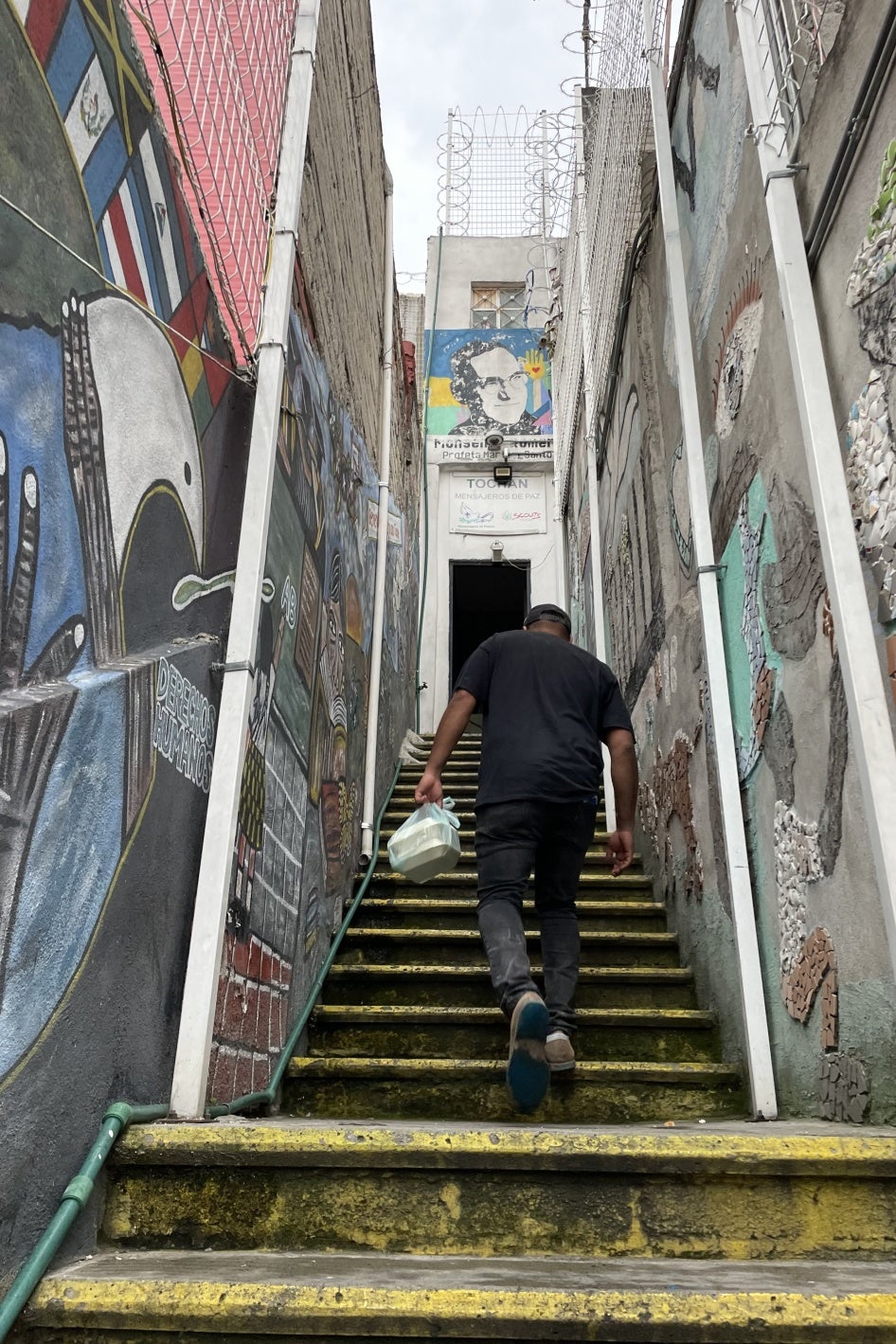
Migrant shelter workers told Human Rights Watch that CBP One, which is geofenced to operate within a certain distance of the border, including Mexico City and other northern Mexico cities, has upended their operations. Previously, asylum seekers would stay at shelters for short periods of time—often only a matter of days. They now spend much longer waiting for a CBP One appointment, creating a greater need for services like medical and psychological care. [42] Many shelters, which typically do not receive government funding, have extended the time periods for which asylum seekers are permitted to stay, but with an ongoing need for shelter among newly arriving asylum seekers, they have needed to turn many asylum seekers away or ask existing asylum seekers to leave. While some shelters allow people to stay for up to a month, many are only able to offer a few days of shelter.
Several asylum seekers told Human Rights Watch that they had no choice but to cross irregularly to turn themselves in because they no longer had anywhere to stay in Mexico. [43]
When asylum seekers have questions about how to use CBP One, there is no one at CBP they can call, fueling a high level of confusion and misinformation around how to use the application. [44] For those needing help, there is only an email address they can contact, showing the lack of urgency around response and additional digital literacy and accessibility barriers. The US government has given some trainings to shelter workers in Mexico, but there continues to be high levels of confusion, including among shelter workers who told Human Rights Watch that they continued to have problems with the function of the app. Many asylum seekers told Human Rights Watch that they tried to troubleshoot application errors or avoid long wait times by deleting their accounts and re-registering several times, while others said they were forced to re-register because they’d entered information incorrectly, exposing them for longer periods of time to targeted abuse in Mexico. [45]
CBP One is also difficult for asylum seekers to access because many are simply unfamiliar with smartphones. According to a 2022 World Bank report, many asylum seekers applying to the US have fled countries with very low smartphone penetration rates per household. [46] While a 2021 study found that 85 per cent of people in the United States own a smartphone, [47] Mexico and countries in Central and South America have lower internet and smartphone penetration. More advanced 4G technologies have a penetration rate of only 37 percent in Mexico and Central America due to “the lack of high-speed fixed broadband infrastructure, the high costs of data and devices, the lack of digital skills, and the unavailability of relevant, local-language content.” [48] Only 5 percent of households in Haiti have access to a fixed internet connection, 25 percent in Nicaragua, 31 percent in Guatemala, 40 percent in Honduras, 43 percent in El Salvador, 55 percent in Bolivia, and 65 percent in Mexico. [49] There was no data on Venezuela, but a 2018 Pew Research report found 32 percent of Venezuelans did not own a mobile phone, let alone a smartphone. [50] Asylum seekers who have not had practice using smartphones should not be forced to learn in life-threatening circumstances.
Identity-Based Barriers
While some asylum seekers Human Rights Watch interviewed were not aware of the existence of the CBP One app, most knew about it but had problems using it. [51] Nearly all of those we spoke with reported having trouble using CBP One, often due to some aspect of their personal identity. [52]
Black and Brown asylum seekers may face barriers to using CBP One as the app uses facial recognition technology to verify an asylum seeker against their identity documents. Asylum seekers must allow the app to take a photo of their faces when registering on the app and again to confirm their appointment and often receive error messages. Asylum seekers and migrant shelter workers reported having trouble getting the selfie to work with asylum seekers with darker skin tones and having to shine a bright light on asylum seekers’ faces in an attempt to lighten their skin tone and make themselves recognizable to the app. [53]
Asylum seekers experience language barriers in accessing CBP One. As has been well documented by legal service providers and human rights workers, CBP One is inaccessible to many asylum seekers, including those without access to a smartphone or the internet, those who do not speak one of the few languages available in the application, are not able to read, have never used a smartphone and do not understand how to use CBP One or any other mobile applications. [54] The app is only available in English, Spanish, and Haitian Creole, but arriving asylum seekers speak a multitude of other languages, including those who come from Asia, Africa, the Middle East, Europe, and Indigenous communities in the Americas.
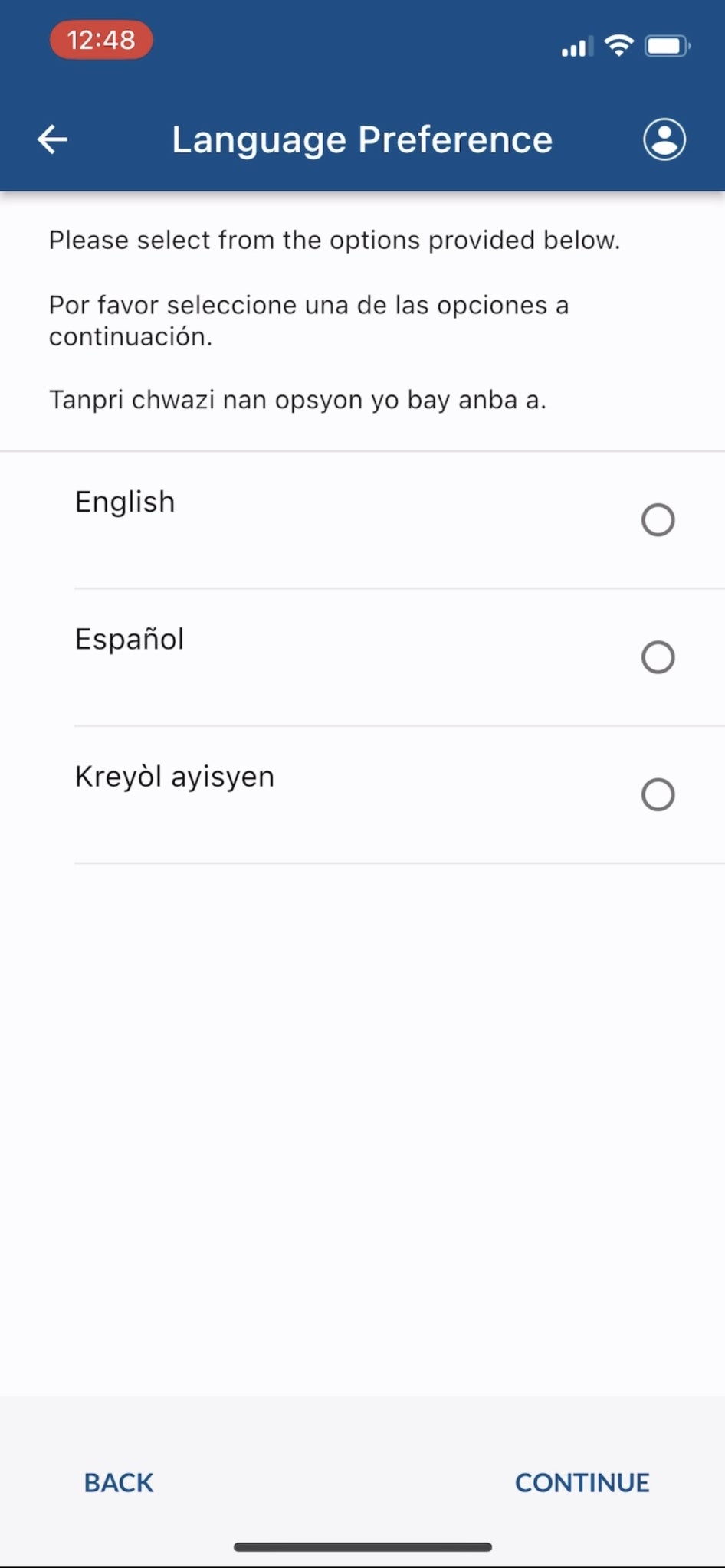
The app is also inaccessible to those with limited literacy skills. A volunteer at one migrant shelter in Monterrey, Mexico, told Human Rights Watch that about one in every 10 asylum seekers he assisted in using CBP One could not read. [55] Another shelter worker in Monterrey told Human Rights Watch he worked with a man seeking asylum who could not read. [56] After helping the man set up his CBP One account, the shelter worker taught the man how to request an appointment each day by helping him memorize the selection pattern based on the sequence of icons and images. [57] “If you see something different, come here to talk to us,” he told the man. [58] “A lot of people [cannot read], but they have a functional ability to fill out their basic information,” said Beatriz Fuentes, director of Casa Fuente in Mexico City. “CBP One goes beyond what they are functionally capable of.” [59]
Lesbian, gay, bisexual, and transgender (LGBT) asylum seekers face unique challenges in accessing the Wi-Fi, which in turn thwarts their access to the app. Shelter operators and asylum seekers told Human Rights Watch that many migrant shelters—asylum seekers’ main source of Wi-Fi and makeshift tech support, helping people access the app and troubleshoot app errors—are religiously affiliated and some have turned away LGBT asylum seekers [60] or otherwise discriminated against them based on their sexual orientation or gender identity. [61]
Older adults reported to Human Rights Watch they were unfamiliar with the use of smartphones and struggled to use the application. For example, Paulina I., 56, who is traveling with her husband, 62, had to ask a shelter worker in Nuevo Laredo for help to register on CBP One. She said they did not understand how to use this or other apps, have very little experience using smartphones, and struggled to input a Human Rights Watch researchers contact information into her phone. [62] Lena G., 56, relies on her young nephew to operate the application. [63] Family members, friends, acquaintances, or shelter workers may not input information correctly for older adults, jeopardizing the parole and asylum processes of users. And asylum seekers who need help using the app may be forced to share personal information in ways that put them at risk.
The app may also be more difficult to use for people with disabilities, including those who cannot see or who experience an intellectual disability. Workers at Casa Tochan, a migrant shelter in Mexico City, told Human Rights Watch they provided housing to an asylum-seeking man who was blind. [64] The man hoped to receive medical treatment in the United States in the hope of regaining some of his sight, but he could not use the CBP One application. [65] Some other asylum seekers ended up helping the man create an account and request an appointment, the workers said. [66]
Damaris C., a 30-year-old woman who fled Colombia with her husband and their 8- and 15-year-old sons, told Human Rights Watch that her teenage child had become responsible for managing CBP One since her husband could not see well enough to use the app and she did not “know anything about technology.” [67]
Use of CBP One Is Effectively Mandatory
While the US government claims that having a CBP One appointment is not required for asylum seekers to be processed by CBP officials, that has been the practical effect of the May 2023 rule promulgated by the Biden administration.
According to the rule, “Noncitizens are not required to make an appointment in the CBP One app to present at a POE (port of entry), and CBP policy provides that in no instance will an individual be turned away from a POE.” [68]
Despite this, Human Rights Watch has documented cases in which border agents have turned away asylum seekers without appointments, including Mexican nationals. Mexican officials have also prevented people without appointments from approaching ports of entry. As a result, asylum seekers have virtually no choice but to use CBP One. [69]
The first reason that CBP One is effectively mandatory is that people are turned away at the border when they do not use the app. As before May 2023, CBP agents cite capacity issues when turning away asylum seekers without an appointment, but they now also cite the new rule. [70] Human Rights Watch observed CBP officers at the Laredo port of entry tell Sandra S. that they had already processed everyone they were going to process that day, all of whom had an appointment via CBP One, and that they did not have capacity to process more people. [71] This response contradicts the rule because Sandra S. is a Mexican citizen and the new Biden rule clearly states that Mexicans have an exception from the CBP One appointment requirement.
The second reason that the app is effectively mandatory is because of the punitive treatment experienced by asylum seekers who cannot or do not use it. Under the rule, the Biden administration has re-upped the Trump-style expedited removal process for asylum seekers without a CBP One appointment.
CBP officials have discretion in deciding whether non-Mexican asylum seekers without a CBP One appointment should be placed into expedited removal proceedings. Overcoming the rule’s “presumption of asylum ineligibility” while in expedited proceedings, often in the custody of CBP, is exceedingly difficult and exacerbates harm.
While expedited removal predates both the Biden and Trump administrations, it was the Trump administration that first modified the policy such that it would target asylum seekers and require detaining them for several days or weeks in CBP temporary detention facilities designed to house people for no more than 72 hours. [72] Many migrants held without meaningful access to attorneys or family in CBP custody face inhumane and abusive detention conditions, including sexual assault, physical violence, verbal abuse, lack of access to adequate medical care or showers or other hygienic needs, frigid temperatures, and overcrowding. [73]
Reporting by Human Rights Watch and many others has shown CBP agents implementing expedited removal have abused border crossers and residents with near-total impunity for decades, [74] have lied on official paperwork for asylum seekers, [75] and have illegally turned back asylum seekers at ports of entry. [76] Asylum seekers placed in enhanced expedited removal face return to the countries they have fled or to Mexico without meaningful access to due process. [77] In CBP custody, without time or the ability to gather evidence, non-Mexican asylum seekers are interviewed by asylum officers to determine whether they “can establish a reasonable possibility of persecution on account of a protected ground or face torture in the country to which [they] will be ordered removed.” [78]
Most of the non-Mexican asylum seekers we spoke with who had been placed into expedited removal proceedings under the asylum rule and deported to Mexico said they were held for weeks in CBP border jails with very little or no access to phones or attorneys.
Asylum seekers who are placed into expedited removal and are unsuccessful in presenting their claims for asylum are often removed from the United States with a five-year legal bar on returning to the United States, and a direct threat in the Biden rule of criminal prosecution should they attempt to return, and non-eligibility for the parole program. [79]
Under the enhanced expedited removal provisions of the Biden asylum rule, “DHS has repatriated approximately 126,000 noncitizens under Title 8 authorities, including single adults and [families,] to more than 100 countries between May 12 and July 31, 2023,” according to DHS Assistant Secretary for Border and Immigration Policy Blas Nuñez-Neto. [80]
These punitive measures for those who do not use CBP One make the app de facto mandatory for asylum seekers.
In light of all these factors, asylum seekers are forced to wait in Mexico. The scarity of appointments adds another layer of pressure to this system since CBP restricts the number available each day, forcing asylum seekers to wait for weeks or months [81] for an appointment in dangerous and unhealthy conditions in Mexico.
The US government claims that “scheduling appointments makes the process safer and more orderly, and the advance information that is submitted to CBP Officers creates a more efficient and streamlined process for CBP and for individuals.” [82] However, HRW has found the reality to be far from this vision of streamlined efficiency.
The Myth of Lack of Capacity
CBP agents have for years cited lack of capacity as the reason for limiting the number of asylum seekers they process, but a 2020 DHS Office of Inspector General report on metering found that CBP officials “used these reasons regardless of the port’s actual capacity and capability.” [83] Often, CBP’s claims about capacity were simply untrue. [84]
The very limited number of appointments available via CBP One fails to meet asylum processing needs, which CBP and Department of Homeland Security (DHS) officials have said reflects CBP’s limited capacity. [85] Capacity, though, largely reflects the administration’s priorities and choices. The US government has significant resources at its disposal to increase humane processing capacity yet has created a vicious cycle: an increase in the number of asylum seekers in expedited removal proceedings being held well beyond the 72-hour limit in inhumane CBP facilities, which generates a need for increased agency capacity that could otherwise be used to process arriving asylum seekers. This in turn contributes to a further processing backlog, as the number of asylum seekers arriving in northern Mexico continues, and people are driven to cross between ports of entry when they are blocked at the ports, making them vulnerable to being placed in expedited removal proceedings.
The App Creates a Digital Metering System
Whereas the metering policy under the Trump administration relied upon analog lists held by Mexican actors or migrants themselves, the digital metering system created by the Biden asylum rule has established CBP as the owner of a border-wide digital metering list. CBP now possesses the knowledge and power to determine who will be processed next, at which port of entry, and when. Asylum seekers must sign up with CBP One and add their names to the digital metering list to ensure they will be processed by CBP and allowed to seek asylum in the United States. If they do not, they face routine turnbacks by either US or Mexican officials, outlined in greater detail in the following chapter.
CBP does not provide enough appointments to meet the demand from asylum seekers. The agency initially provided 1,000 CBP One appointments each day, raising the number of available appointments to 1,250. In June 2023, CBP increased the number of available appointments to 1,450 each day. [86] Between May 2023, when the Biden asylum rule was implemented, and January 2024, border arrivals averaged about 7,240 per day. [87]
CBP reported that between January 2023 and February 2024, more than 501,000 asylum seekers had been paroled into the United States after requesting a CBP One appointment, including in processes predating the asylum rule, which went into effect in May 2023. [88] While high, that number is a small fraction of the 64 million requests asylum seekers have made for a CBP One appointment between May 2023 and February 2024. The high number of requests reflects the fact that, under the asylum rule, people must apply each day as new appointments become available until they secure a time and day to appear at the border post. [89]
Human Rights Watch documented wait times for people seeking appointments via the CBP One app ranging from a few days to four months. Most asylum seekers with whom Human Rights Watch spoke said they, their families, or friends they were travelling with had been waiting for a month or more in Mexico. [90]
Though the Biden asylum rule is designed to deter most arriving asylum seekers, the rule has not deterred people from trying to enter the United States to seek safety. [91] With US ports of entry effectively closed to most asylum seekers who do not have a CBP One appointment, inability to access the digital metering system contributes to irregular border crossings and jeopardizes asylum seekers’ protection claims under the Biden asylum rule.
Turnbacks of Asylum Seekers
In tandem with the Biden asylum rule and digital metering policy, US officials work with their Mexican counterparts to prevent asylum seekers from reaching the US border and requesting access to asylum in the United States. Human Rights Watch documented efforts by the US and Mexico to conduct “turnbacks”—blocking people from entering the United States and pushing them back to Mexico—of asylum seekers at ports of entry at the US-Mexico border. The US CBP One appointment system is cited by officials of both governments when blocking asylum seekers from accessing the border. Turnbacks are therefore the dangerous result of digital metering and the Biden asylum rule.
Against this high-level backdrop, officials from both the United States and Mexico participate in blocking asylum seekers from accessing protection. [92]
Turnbacks by CBP
CBP regularly turns asylum seekers back at the border. Agents posted at the midpoint of international bridges—the recognized boundary between the United States and Mexico—require every person who attempts to approach border stations to show identification and evidence of authorization to enter the United States. They typically turn back asylum seekers who do not have CBP One appointments.
In one such case, Denny G., a 33-year-old Cuban asylum seeker, who had been waiting in an Nuevo Laredo encampment for a month, said he tried to enter at a port of entry, but was turned back by CBP officers on the middle of the bridge. [93] Denny said he planned to try again along with four other asylum seekers he had met on the journey in the hopes that there would be strength in numbers. [94] “There is too much violence here,” Denny said. “Why don’t they process the people waiting here at the encampment?” [95]
CBP agents often turn people back at the border even when they attempt to explain that they face danger in Mexico. For instance, Lara D., a 23-year-old asylum seeker from Venezuela, traveled by car via the rideshare application DiDi to the Laredo port of entry. About two blocks from the international bridge, a black truck carrying two armed men pulled out in front of the car, forcing the vehicle to stop. [96] One of the men got out of the truck and got into the car Lara was in with her husband, cousin, and parents. He began “speaking very strongly” with the DiDi driver, telling him to take another route. The man told Lara and her family that they needed to be registered and that their photos would be taken and information collected. The rideshare driver accelerated suddenly, launching the car forward with the door open and causing the armed man to fly out of the car. The driver left Lara and her family at the entrance to the Laredo port of entry, and the family hurried across the bridge. On the middle of the bridge, they were blocked by CBP officers who, despite having been told about what had just befallen the family and that they had a fear of returning to both their country of origin and Mexico, turned Lara and her family back to Mexico. [97] “[CBP] said they had already processed all the people they were going to process that day and they would not accept us,” Lara said. [98]
In another such case, Human Rights Watch accompanied Sandra S. and her family in their attempt to turn themselves in to CBP Office of Field Operations (OFO) officers at the Laredo port of entry for a second time after they had been identified and threatened by members of a cartel in Nuevo Laredo. [99] Human Rights Watch then witnessed a CBP Office of Field Operations (OFO) agent tell another CBP officer in front of Sandra and her family that asylum seekers had “milked the system” and that they would “not allow them to do it again.” The agent then told the family that any asylum seekers who arrive without proof that they have filed a police report would be automatically turned away. [100]
A CBP officer who identified herself as a supervisor then told Sandra and her family that they would need to go back to Nuevo Laredo to wait for a CBP One appointment. [101] When the family remained on the bridge to plead their case, standing in heat that exceeded 100 degrees Fahrenheit (38 degrees Celsius), CBP officers threatened to call the Mexican National Guard to remove the family from the bridge if they did not leave of their own accord. [102] By this point, the CBP agents involved had heard the family’s account of the threats and danger they would face upon return to Mexico and were made aware of the additional protections that apply to people fleeing Mexico, but nonetheless turned the family back. [103]
In Sandra’s case, not only did CBP agents inaccurately insist that CBP One was the exclusive means for an asylum seeker to secure entry to the United States, but they also imposed an invented standard for an asylum claim.
There is no requirement to file a police report to apply for asylum in the US, nor are asylum seekers required to show CBP evidence of their asylum claims. In fact, it is not CBP’s role to adjudicate asylum claims. Sandra and her family did not feel safe speaking to the Mexican police and had not filed a police report. [104] Among other concerns, Mexican law enforcement officials have extorted migrants and have also been implicated in working with organized criminal groups to kidnap and otherwise harm them. [105]
Sandra and her family were living in a makeshift encampment of roughly 100 people in Nuevo Laredo when we visited in early September 2023. The encampment is located in Mexico, across the border from Laredo, Texas. Asylum seekers, including many young children, sleep there beneath suspended tarps with no walls, security, or basic services.
There were nine Mexican citizens total in the encampment at the time, all of whom reported having been turned back by Mexican or US officials at the Laredo port of entry. [106]
Mexican officials sometimes repeat the same excuse.
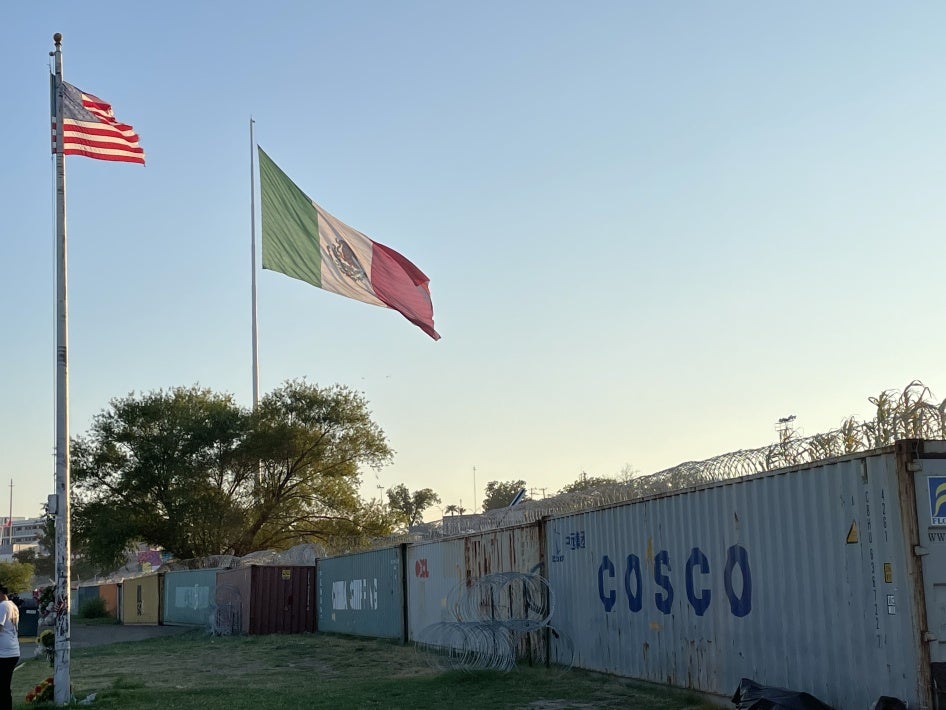
Natalia V., 25, fled Venezuela with her husband, 28, their five children, between the ages of 1 and 9, and her father-in-law. When they arrived at the Eagle Pass port of entry, Natalia was exhausted and sick. They had been traveling for four months and had completely run out of money. With no resources in Mexico, they said they needed to enter the United States immediately and join their family in Chicago. Natalia and her family tried to present themselves to CBP officers at the port of entry but were turned back by Mexican guards because they did not have a CBP One appointment. They tried to cross the Rio Grande near the port but were told to go back to the bridge.
“The [US] soldiers yelled at us, but we could not cross the bridge because security turned us back,” Natalia said. “The loop was infinite. They told us to cross the bridge. We could not cross the bridge and then we could not turn ourselves in between ports of entry.”
They ended up waiting four hours in the severe heat near barbed wire between ports of entry for Border Patrol to arrive. “We couldn't wait,” she said. “We had to turn ourselves in.” [107]
Mexico’s Role in Turnbacks
CBP has repeatedly claimed it has no agreement with Mexican authorities requiring the latter to assist the US in turning back asylum seekers who arrive at a US port of entry without a CBP One appointment. Yet Human Rights Watch found evidence of close collaboration.
Some asylum seekers told Human Rights Watch the sight of Mexican government officials, especially armed officials, at ports of entry discouraged them from attempting to approach CBP officers to seek asylum.
Betty C., a Venezuelan woman traveling with her family of five, including two children, told Human Rights Watch the sight of Mexican National Guard soldiers in front of the Laredo port of entry kept the family from seeking asylum. The family had been waiting in the makeshift encampment in Nuevo Laredo for three weeks when we spoke with her. [108]
“We are afraid to get close to the authorities in Mexico because we are worried they will detain us and send us to the south [of Mexico],” Beatriz said. “I want to enter legally, but I don’t know how.” [109]
Since the Biden asylum rule was implemented, Mexican government officials, or security contractors, have typically been present on the Mexico side blocking access to the international bridge. These government officials, or representatives, actively screen asylum seekers for CBP One appointments at all eight ports of entry for which appointments are assigned. [110] Asylum seekers who cannot show proof of an appointment are usually barred from accessing the port of entry. [111]
The chart below outlines the Mexican governmental agencies or contractors involved in blocking asylum seekers from accessing asylum procedures in the United States.
Mexican Agencies and Contractors Barring Access to US Ports of Entry
Denny G., a Cuban asylum seeker whose case is described above, said he tried to enter a port of entry twice, but was turned back—once by CBP officers at the middle of the bridge and once by Mexican National Guard soldiers. Such Mexican soldiers, armed and uniformed, stand in front of the bridge’s entrance and prevent asylum seekers without a CBP One appointment from crossing. [112]
Paulina I., a 56-year-old woman fleeing Guerrero, Mexico, with her husband after cartel operatives extorted, threatened, and kidnapped the couple, reported they were turned away at the Laredo port of entry in August 2023 by Mexican officials. The couple had fled their hometown after they could no longer afford the extortion payments the cartel was demanding. On their way, the cartel kidnapped them and threatened to kill them, eventually releasing them but keeping the couple’s truck and the farm animals they were traveling with. [113]
“We had to choose between our truck and our animals or our lives,” Paulina said. [114]
When they arrived at the Nuevo Laredo bus terminal, several strangers, who Paulina and her family believe were cartel operatives, questioned them at various times about what they were doing in the city. To avoid confirming they were seeking asylum in the United States, they replied they were visiting someone. When they got to the Laredo port of entry where they hoped to turn themselves in to CBP officers, they were stopped by Mexican National Guard soldiers who asked if they had a CBP One appointment. The soldiers sent them to speak to INM agents, who, seeming surprised, asked the couple whether they had not already been stopped by anyone at the bus terminal. The agents gave them a list of migrant shelters to stay at in Nuevo Laredo and turned them away. All the shelters were closed, and the family’s only option was to wait in the insecure makeshift encampment near the US port of entry. [115]
Alex H., 26, fled death threats from cartel members in Honduras in June 2023 and had been waiting for an appointment via CBP One for 45 days in Monterrey with his mother. The two ran out of money, so Alex began working a construction job. While working one day, an arc of electricity passed from a tool to his body, and he sustained third-degree burns over much of his skin, including on his torso, arms, legs, and neck. Human Rights Watch first spoke to Alex as he lay in a rudimentary health clinic, unable to walk. The clinic, adjacent to a migrant shelter, usually treats people who have lost limbs after falling from the cargo train migrants often ride through Mexico to the border. Alex had developed a rare fungal infection in some of the burn wounds. He was unable to access the medical care he needed in Mexico, he said, including the anti-fungal medicine clinicians told him he needed and could find in the United States. [116]
CBP said Alex and his mother would be allowed to cross the border and even offered to schedule an ambulance to take the family directly to a hospital. However, when the two arrived at the Mexico side of the Eagle Pass port of entry in September 2023, guards with Grupo Enlace, an agency with the city of Piedras Negras government, told the family that without a CBP One appointment, they could not cross the international bridge. [117] The guards told Alex and his mother they already had called CBP and been told the family did not have permission to cross. [118] The family was eventually able access the port of entry and rushed to the hospital, but only after repeated intervention of human rights monitoring groups and groups providing legal services, including Human Rights Watch, Witness at the Border, Al Otro Lado, and Mission: Border Hope, and only after hours of waiting in severe heat—a serious health risk for Alex.
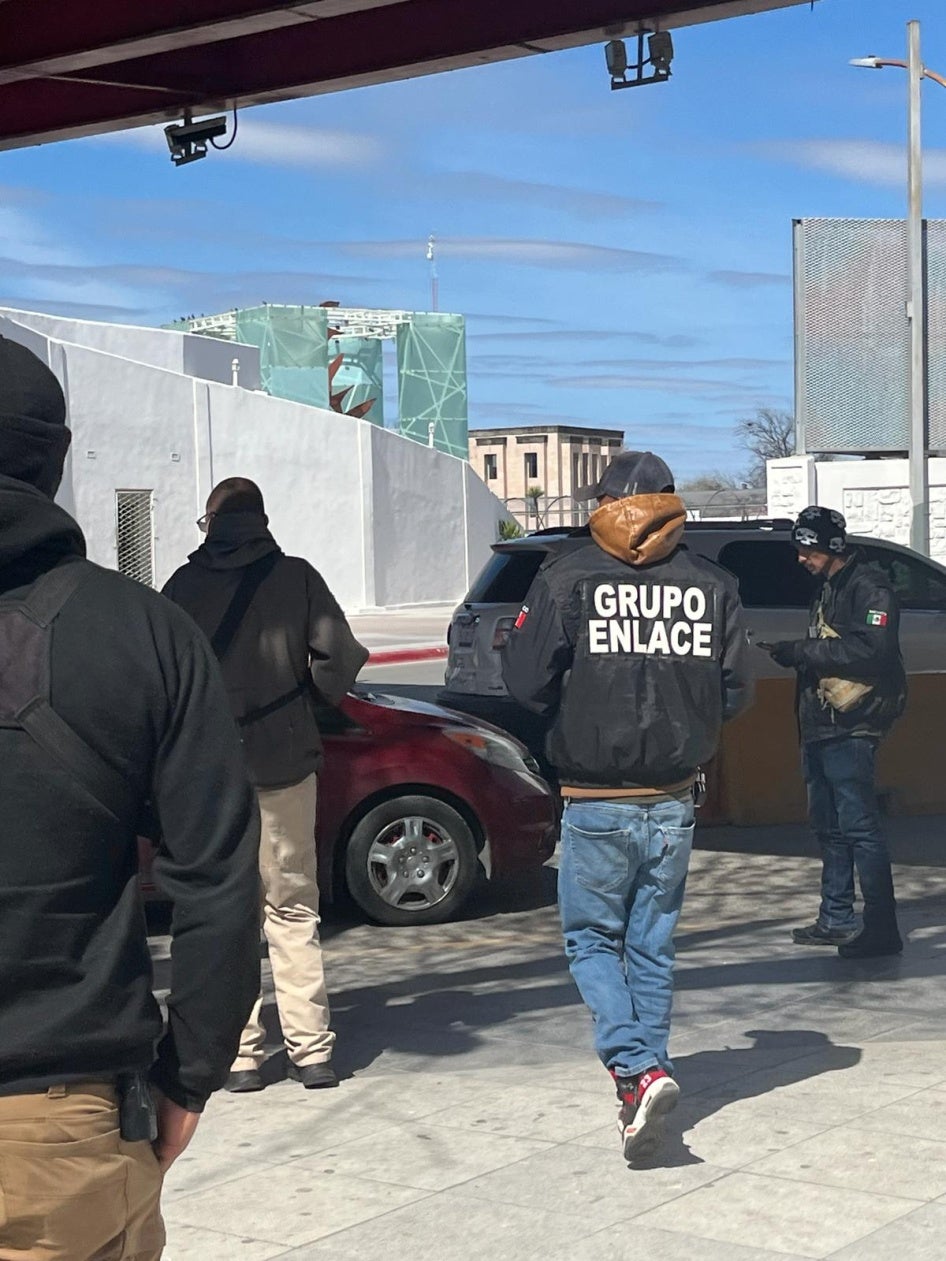
Two days earlier, Human Rights Watch had spoken to a man who identified himself as a Grupo Enlace supervisor. [119] “We are working with Mexico and the United States to ensure that only people with CBP One appointments can cross,” he said. [120]
The supervisor said security guards are posted in front of the international bridge entrance 24 hours a day, where they screen people for appointments. He said they stop both Mexican and non-Mexican asylum seekers who do not have an appointment. He said he was not aware of any law that states Mexicans have a right to leave their country, was not aware of the responsibility of state agents, including contractors hired by the government, not to engage in acts of refoulement, and had received no training on refugee protection laws. [121]
The supervisor repeated his statement that the guards were working for the United States within hearing of three other Grupo Enlace guards standing next to him. [122] Grupo Enlace, an agency under the city of Piedras Negras, Coahuila, is managed by the Piedras Negras Mayor’s office, including City Manager José Hermelo Castillón Martínez, who the supervisor identified as the person managing the agency’s day-to-day operations, and Piedras Negras Mayor Norma Treviño Galindo. [123]
Neither Castillon nor Treviño responded to questions from Human Rights Watch about the activities of the Grupo Enlace guards. The city communications manager, Jesús Chávez Martínez, said the Grupo Enlace guards are “citizen guards” the city posted there to prevent migrants without permission from entering the United States from accessing the bridge. [124] He said the Grupo Enlace presence is part of “a deal for the US to open its bridges again for Mexicans.” [125]
On September 20, 2023, the US government closed one of the international bridges between Piedras Negras and Eagle Pass, Texas for five weeks, citing an increase in the number of arriving migrants. [126]
Harms in Mexico
Targeting by criminal operatives and government officials.
Conditions faced by asylum seekers in Mexico while they are caught in the US digital metering system are unsustainable and can be life-threatening. Human Rights First has published at least two investigations documenting scores of cases of kidnappings, extortion, sexual violence, disappearances, and other types of harm perpetrated against asylum seekers in Mexico since the Biden asylum rule went into effect. [127]
The US policies blocking asylum at the border in recent years have changed in name and severity, but one material outcome for asylum seekers has remained the same: asylum seekers are forced to wait in northern Mexican states, as well as in many cities in other parts of the country through which migrants transit, where they are systematically targeted by cartels, sometimes with the help of Mexican government officials, for kidnapping, extortion, sexual assault, robbery, and other abuse. Human Rights Watch has documented how Mexican immigration officials or police have turned migrants over to cartels for kidnapping and extortion. [128] In November 2023, the mayor of Matehuala, a city in the central Mexican state of San Luis Potosi, was arrested for his part in a migrant kidnapping ring from which 27 people were rescued in April, along with the chief of police, according to a report about the police investigation. [129]
As detailed below and in previous research, cartels—transnational criminal organizations—monitor the entry and exit of migrants into particular locations, especially at the border, and they have well-established practices for conducting targeted kidnappings and extortions of migrants. [130] They track migrants in transit, sourcing information from taxi or rideshare drivers, migrant shelters, and observing migrants at outdoor encampments. They operate with near total impunity.
The kidnapping and extortion of migrants as a cartel business model grew as the result of the Trump administration’s metering policy, Remain in Mexico, and rapid expulsion policies that expose migrants to harm in Mexico, often for extended periods of time. [131] Human Rights First documented 1,544 publicly reported cases of kidnapping and other violent attacks of migrants during the first two years of Remain in Mexico. [132] That figure expanded under the Biden administration to 13,480 as of December 2022. [133] Under the Biden asylum rule and digital metering, kidnapping and extortion rings targeting migrants have expanded further, with reports of new kidnapping operations in cities in central Mexico, including Torreon and Durango. [134]
“Migration became an international business, and they wanted a cut,” said Raymundo Ramos, director of the Comité de Derechos Humanos de Nuevo Laredo. “Cartels, especially in the north, started seeing migrants as part of their business model.” [135]
Ramos said that while his organization has observed a steady increase in kidnappings of migrants at the border and has supported victims, they do not dare document kidnappings publicly or report them because doing so would make them targets for violence as well. [136]
In other parts of Mexico, migrants in transit are frequently targeted by Mexican government officials and criminals for extortion, and other abuses. Asylum seekers, shelter workers, and commercial bus company employees told Human Rights Watch that Mexican police, National Guard soldiers, INM agents, or cartels frequently stop and board commercial buses—a primary means of travel through Mexico for migrants—and racially profile and extort money or phones from migrants on board. [137] Mexican police and private security also have targeted migrants for extortion on cargo trains, they said, which migrants ride atop of when safer pathways are not accessible. If migrants cannot pay the requested sum, they risk being forcibly taken to southern Mexico by Mexican immigration officials, kidnapped, sexually assaulted, or otherwise harmed. Human Rights Watch has also previously documented the kidnapping of migrants by police in Mexican border cities. [138]
Kidnapping for Ransom and Sexual Violence
The more difficult it is for migrants to cross the US-Mexico border, the more money cartels make, whether from smuggling operations or from kidnapping and extortion. Criminal actors also have near impunity when sexually assaulting asylum seekers, given the fear and power imbalance smugglers can exploit due to US policies of digital metering.
Human Rights Watch documented reports of kidnapping for ransom from migrants in each of the five Mexican cities in which we conducted interviews. [139] In one case, a man kidnapped in Durango, in the Mexican state of Durango, reported seeing about 150 other kidnapped migrants there in the stash house where he was being held. [140] Durango has been the site of several mass kidnappings of migrants by cartel operatives. [141] In another case, a migrant who had been kidnapped for ransom by men who identified themselves as belonging to “the cartel” in Mexicali, Mexico, near the Calexico US port of entry, said he witnessed cartel operatives shoot and kill two Honduran migrants when they tried to defend themselves. [142]
Eddy L, 40, a Venezuelan asylum seeker, said an INM agent stopped a bus he was riding and took him off it when he had no money and could not pay the amount she was demanding. He was detained and forcibly relocated to the border with Guatemala after being forced to sign an agreement that he would leave Mexico through its southern border. Traveling north once more, he rode atop a cargo train along with hundreds of other migrants and was robbed of his cellphone. Near Celaya, in the Mexican state of Guanajuato, he witnessed around 15 people kidnapped from the train by unidentified men. He managed to run away. [143]
Javi J., 42, a Honduran asylum seeker, was kidnapped in Reynosa, in the Mexican state of Tamaulipas, for two months until his brother could pay a ransom of US$4,000. [144]
Carlos M, 32, told Human Rights Watch he was kidnapped by people who identified themselves as police in Tonalá, Jalisco, Mexico, for three days. [145]
“They hit me and sent photos to my family saying that they would kill me if they didn't pay,” Carlos said. His mother-in-law paid a ransom of US$2,000 for his release, and the police released him at the border with Guatemala. [146]
Nicolas P., 20, a Honduran asylum seeker, was kidnapped shortly after arriving at a hotel in Durango. Men who identified themselves as police, used police uniforms, and used police cars showed up and took him from his room, leading him to believe the hotel staff called them. The police delivered him to a cartel stash house. Cartel operatives took his phone and, after four days, had him call his family, who paid a ransom of US$1,000 for his release. The police then came to pick him up from the cartel stash house and took him back to the hotel, saying “everything has been arranged.” He said he believes the hotel workers, the police, and the cartel are working together to operate an efficient kidnapping ring. [147]
In addition, Beatriz Fuentes, the director of the Casa Fuente migrant shelter in Mexico City, told Human Rights Watch it is common for migrant women to arrive to her shelter having been sexually assaulted. [148]
“Sexual assault has become normalized among women,” she said. “It’s seen as another payment to be able to travel or cross.” [149]
Cartel Coercion and Kidnappings in Nuevo Laredo
The Rio Grande between Laredo in the United States and Nuevo Laredo in Mexico is unmarred by sections of border wall, razor wire, or buoys with saws on them, but few dare cross it without paying and getting permission from the cartel that polices it, according to asylum seekers, migrant shelter workers, and NGO workers there. [150]
With the introduction of the digital metering system, the cartel in Nuevo Laredo has endeavored to charge asylum seekers with a CBP One appointment US$500 for permission to cross and initially wanted shelter workers in Nuevo Laredo to carry out the extortion on their behalf, the shelter workers told Human Rights Watch. [151] Instead of capitulating to the cartels, the shelters closed, leaving thousands of asylum seekers waiting weeks and months for their CBP One appointment in a makeshift encampment about two blocks from the US port of entry, with no security or access to basic services. [152]
Many asylum seekers told Human Rights Watch they saw cartel lookouts surveilling the river to ensure asylum seekers are not able to turn themselves in to CBP there, and that cartel operatives visit the makeshift refugee camp, taking photos of the asylum seekers, including children, warning them that they will be seriously harmed if they try to cross the border without paying. [153]
The cartel also kidnaps migrants directly from the bus terminal in Nuevo Laredo. [154] Taxi and rideshare drivers in Nuevo Laredo are reportedly forced to participate in a WhatsApp group they share with cartel operatives where they must notify the cartel when they have migrant passengers and turn migrants over to the cartel when asked. [155] Even the migrant shelters had been compromised while they were still open, with some workers extorting migrants on behalf of the cartel, while others turn over migrants’ identifying information to the cartel on a regular basis, the workers themselves told Human Rights Watch. [156]
Forced Relocation of Asylum Seekers to Southern Mexico
The Mexican government also apprehends some non-Mexican asylum seekers at the US border before they can reach the United States and relocates them to southern Mexico, where they are typically pressured to sign written agreements to leave Mexico via its southern border. The Mexican government also summarily deports asylum seekers to their country of origin, typically without screening to ensure they are not being returned to harm.
Virginia Z., a 47-year-old Venezuelan asylum seeker traveling with her 11-year-old son, told Human Rights Watch the family was attempting to turn themselves in at the Eagle Pass port of entry in August 2023 when INM agents near the international bridge “grabbed” them, she said, put them on a bus, and relocated them to the state of Tabasco, which borders Guatemala. [157] Traveling north once again through Mexico, Virginia lost her phone and had to create a new CBP One registration using someone else’s phone. She had been waiting for two months in Nuevo Laredo when we spoke with her. [158]
York G., a 28-year-old Haitian asylum seeker, told Human Rights Watch he was waiting for a CBP One appointment in Piedras Negras in June 2023 when INM agents apprehended him, put him on a bus, and relocated him near the Mexican border with Guatemala, saying they were doing it on behalf of the United States. [159] York told a Human Rights Watch researcher, “The agents told me, ‘We have to deport [relocate] you, we are not doing it because we want to. It is not anything to do with you being Haitian or Black,’” York said. “They said they had to do a certain number of removals set by the US government.” [160]
Mexican President Andrés Manuel López Obrador has repeatedly agreed to block migrants from arriving at the US southern border, including by using Mexican authorities to apprehend asylum seekers in border cities and relocate them to southern Mexico. [161]
York said he experienced discrimination and abuse in Mexico at the hands of Mexican government officials. After being relocated to southern Mexico by Mexican government authorities, he traveled north again and had been waiting for his appointment for two-and-a-half months at the time we spoke with him. [162]
US Removals of Non-Mexicans to Mexico
Since May 2023, when Mexico agreed to accept removals and voluntary returns of non-Mexican nationals from the United States, CBP has sent thousands of people across the border. [163] Earlier, under separate agreements, the United States sent more than 77,000 people, mostly from Honduras, Nicaragua, Cuba, Guatemala, El Salvador, Venezuela, Colombia, and Ecuador, to Mexico pending US asylum hearings, [164] and it also carried out summary expulsions more than 2.8 million times, [165] including hundreds of thousands of expulsions to Mexico of migrants from mostly Honduras, Guatemala, El Salvador, and Haiti. [166]
Under the Biden asylum rule, asylum seekers are sent to Mexico either because they were deported in the enhanced expedited removal proceedings or they agreed to a “voluntary return” to Mexico. [167] Some non-Mexican asylum seekers told Human Rights Watch they were warned by CBP officials that they would not be granted asylum and that they would face deportation with a 5-year bar on return to the United States if they did not agree to return to Mexico—typically without screening to ensure asylum seekers were not being returned to harm in Mexico. [168] The non-Mexican asylum seekers said CBP officials told them they would be able to wait for a CBP One appointment and access the US asylum system if they agreed to be sent to Mexico. [169]
However, when US CBP officials carry out removals or returns of non-Mexican asylum seekers—Haitians, Nicaraguans, Venezuelans, and Cubans—to Mexico, they turn them over directly to Mexican INM agents, [170] who often apprehend them, place them on buses they are not allowed to leave for up to three days, and relocate them to Villahermosa, Tabasco, at the border with Guatemala, without screening for protection needs. [171] When effectuating these forced relocations, which INM calls “assisted returns” or “transfers,” [172] INM officials often compel asylum seekers to sign a statement saying they will leave Mexico via its southern border within a certain number of days. [173]
Asylum seekers told Human Rights Watch that INM agents yelled at them and would not allow them to read what they were signing. They said INM agents also never asked them if they had a fear of return to their home country or to Guatemala. [174]
From May through September 2023, the National Institute of Migration (INM) told Human Rights Watch it had received 31,409 non-Mexican migrants sent by the United States to Mexico. [175]
That number is higher than data inconsistently cited by the US government over the same period. CBP said over 17,000 non-Mexicans had been deported to Mexico from May through September 20, 2023. [176] Also citing data from May through September 2023, DHS Assistant Secretary for Border and Immigration Policy Blas Nuñez-Neto reported CBP had removed about 21,000 non-Mexican nationals to Mexico. [177]
CBP data show nearly a 10-fold increase in transfers of all migrants since the Biden asylum rule went into effect in May 2023 and since Mexico agreed to accept US returns and removals of non-Mexicans, also in May: from 3,552 people in April, when those transferred were Mexican nationals only, to 30,009 people in August, with transfers then including Mexican and non-Mexican nationals. [178]
As part of an agreement with the US government, the Mexican government also summarily deports non-Mexican asylum seekers to their home countries after apprehending them in Mexican border cities, before asylum seekers have a chance to seek asylum in the United States. [179] Since the asylum rule went into effect, Mexico has made an official and public agreement with the United States to apprehend more asylum seekers at its border with the US and send them to their home countries by land or air. [180]
“Mexico continues to do the United States’ dirty work,” said a Mexican human rights worker and attorney with extensive experience with asylum seekers on the Mexican side of the border who spoke to Human Rights Watch on condition of anonymity. “[After CBP sends them to Mexico], they're given to Mexican immigration who take them on a bus to Tabasco, Mexico.” [181]
According to an October 2023 report, the INM paid private bus company ETN Turistar 490 million pesos (US$28.5 million) to transport to the Mexico-Guatemala border migrants and asylum seekers apprehended by Mexican authorities or removed or sent by the United States to Mexico. [182] The contract expired December 31, 2023, and was reportedly not renewed. [183]
The López Obrador administration summarily deported more than 53,300 migrants to their country of origin in 2023, 122,000 in 2022, and 130,000 in 2021. [184]
Lena, 56, and her nephew Fernando, 24, fled Venezuela and then Colombia with Lena’s son, daughter-in-law, and their two children. After a long and harrowing journey, they turned themselves in outside the Eagle Pass port of entry. CBP then separated the family three ways: Lena’s son, wife, and children were allowed to enter the United States, while Fernando was sent to El Paso and held in CBP custody for 16 days, and Lena was sent to Laredo for a few days and then to El Paso. In total, Lena was held in CBP border jails for 22 days, where she said she was only questioned by CBP agents about whether she had a fear of return to Mexico, not to her country of origin. [185]
Fernando told Human Rights Watch that CBP tried to get him to accept a “voluntary” return to Mexico. [186] “Border Patrol kept telling me that if I continued to insist on my fear of return then I would be deported,” Fernando said. “They told me dozens of times.” [187]
At separate times, and without allowing them to communicate with one another, CBP deported Lena and Fernando to Mexico. In both cases, CBP shackled the Venezuelan asylum seekers and accompanied them across the international bridge into Ciudad Juárez, Chihuahua, Mexico, and turned them over directly to INM agents. Their shackles were only removed as the custody transfer occurred. In both cases, INM agents detained them, put them on buses with other deported or returned asylum seekers, and had them driven for three days to forcibly relocate them to Villahermosa, Tabasco, a state bordering Guatemala. INM agents pressured them to sign a document agreeing to leave via the southern border of their own accord. [188]
Because CBP agents never returned Fernando’s personal belongings, he found himself once again in southern Mexico, a country where he and his family had already experienced abuse, with no documents, no cellphone, and no money. Lena arrived a few days later, but the two did not manage to find one another again until they had both made it to northern Mexico once more. [189]
Alana T., 54, left Venezuela with her daughter, 30, her son-in-law, 31, and her four grandchildren, ages 1, 2, 8, and 9. After they crossed the Rio Grande near the port of entry in Eagle Pass and turned themselves in, CBP agents threw away Alana’s diabetes medicine and separated her from the rest of her family. CBP immediately processed her children and grandchildren into the United States but detained Alana for seven days without medical treatment. An immigration judge ordered her removal because she had not arrived with a CBP One appointment. CBP deported her to Mexico, turning her over to INM agents in Nuevo Laredo. INM detained Alana on a bus for three days with 40 other women without letting them get off, forcibly relocating them all in Villahermosa, Tabasco, Mexico, near Guatemala, after which she said they pressured the women to sign a paper agreeing to depart Mexico via its southern border. [190]
Asylum seekers removed or returned by CBP to Mexico and then sent by INM agents from the US-Mexico border to its southern border with Guatemala are often compelled to try to travel north again to attempt to access the US asylum system.
Forcibly relocating migrants and asylum seekers from northern to southern Mexico endangers them and subjects them again to the exhausting journey and gauntlet of abuse migrants pass through in Mexico to reach the United States. Having been denied access to the US asylum system, many are likely to pursue more dangerous irregular crossings to enter the United States.
Risk of Exposure to Harm in Guatemala
It is unreasonable to expect asylum seekers to agree to leave Mexico through its southern border with Guatemala.
The vast majority of asylum seekers Human Rights Watch spoke to said Guatemalan police or immigration officials routinely demanded money from them, threatening to deport them if they did not pay, while, in some cases, violently assaulting them. [191] Asylum seekers reported that Guatemalan officials also stopped and boarded commercial buses and demanded payment from migrants throughout the country. [192]
At least some Guatemalan officials have claimed to be acting on behalf of the US government, although the circumstances of these interactions suggest the officials likely did so to intimidate asylum seekers.
Felipe Z., an asylum seeker who fled Ecuador with his 10 family members, told Human Rights Watch that Guatemalan officials told him they were working for the US government and Guatemalan officials were supposed to be conducting deportations on behalf of the United States when they apprehended the family of 11. [193]
The Guatemalan government has recently agreed in talks with the US government to try to reduce the number of migrants arriving at the US southern border and has in recent years carried out violent crackdowns of migrants along with US Immigration and Customs Enforcement officials in Guatemala. [194] However, there is no indication Guatemalan police or immigration officials are “working for” the US government.
Asylum seekers told us that police and immigration authorities in Guatemala often conducted invasive searches of their persons and belongings, probing with ungloved hands into shoes, socks, waistbands, bras, and underwear. In one case recounted to us, Guatemalan police stole a young girl’s earrings. Asylum seekers reported these types of abuses in interviews in each of the six cities and 10 shelters that Human Rights Watch visited. [195]
Some asylum seekers said women had been sexually assaulted during such searches, including acts of unwanted touching and being forced to undress, by men who identified themselves as Guatemalan government officials. [196]
Pamela D., 23, and Naomi D., 25, cousins who fled Venezuela with their teenage sisters, told Human Rights Watch that armed men in uniforms stopped a bus they were on in Guatemala in the middle of the night. Two armed men then boarded the bus. One of these men took all the male passengers off the bus. The other man began to point a flashlight in the faces of the women and girls. He appeared to be singling out certain women, at which point he would turn off the light and begin sexually assaulting them. He turned off the light when he got to Naomi and reached his hand beneath her clothes, fondling her breasts and genitals before taking her money. [197]
Legal Framework
The United States’ near-exclusive reliance on CBP One to access the asylum system, enforced by CBP agents at the physical border and by Mexican officials, as well as private security guards who appear to be operating at the direction of Mexican officials, likely results in violations of the United States’ obligation to refrain from refoulement—the return of people to likely persecution, torture, or other irreparable harm. In addition, when Mexico blocks people from reaching the United States, transfers people from its northern border, and induces them to exit via its southern border, its actions are also likely to result in refoulement, constituting violations for which Mexico and the United States share responsibility.
Digital metering also deprives people of effective enjoyment of the right to seek asylum and subjects them to discrimination on the basis of race, wealth, and other status, in violation of the United States’ international obligations.
Finally, because asylum seekers turned back under the digital metering system are readily identifiable, share common characteristics, are perceived in Mexican society as a distinct social group, and face harm because they are asylum seekers subject to digital metering, they can plausibly show they face persecution on account of their membership in a particular social group. That is, the digital metering system has the foreseeable consequence of creating more viable asylum claims.
The Obligation Not to Return People to Irreparable Harm
The principle of nonrefoulement prohibits states from transferring anyone, directly or indirectly, to a place where they would have a well-founded fear of persecution, would face a risk of torture or other cruel, inhuman, or degrading treatment or punishment, or would likely suffer other irreparable harm. Refoulement is prohibited by the 1967 Protocol Relating to the Status of Refugees, [198] the International Covenant on Civil and Political Rights, [199] and the Convention against Torture, [200] among other treaties, [201] as well as under customary international law. [202]
The principle is reflected in US law. [203]
US turnbacks of Mexican nationals or anyone with a fear of persecution in Mexico without screening for asylum likely violates the principle because nonrefoulement hinges on a refugee not being returned to a place where their lives or freedom would be at risk, often, but not always, their country of origin. Reflecting this reality, the Circumvention of Lawful Pathways Rule exempts Mexican nationals. [204] Similarly, CBP guidance during prior metering operations has warned that Mexican nationals should not be turned back at the border. [205]
More generally, preventing arriving asylum seekers of any nationality from accessing asylum procedures—the mechanism which allows asylum seekers to be identified as refugees or not—based on whether or not they are able to access CBP One appointments constitutes a likely violation of nonrefoulement. While international refugee law does not formally provide an asylum seeker—a person claiming to be a refugee—the right to enter, the refoulement prohibition provides little latitude when the asylum seeker appears at a land border. As the UN’s refugee agency, UNHCR, which provides authoritative guidance on refugee law, made clear in a 2023 brief to the US Supreme Court:
The “cardinal protection principle” of non-refoulement prohibits State conduct that could “lead[] to” a refugee’s “‘return in any manner whatsoever’ to an unsafe foreign territory.” That certainly proscribes enactment and implementation of a blanket policy of “rejection at the [border] or nonadmission to the territory,” because blanket rejection or non-admission clearly may subject a refugee to direct or indirect refoulement. [206]
The UNHCR’s Executive Committee Conclusion 99 calls on States to ensure "full respect for the fundamental principle of nonrefoulement, including non-rejection at frontiers without access to fair and effective procedures for determining status and protection needs."
The US digital metering system, through the use of the CBP One application and by the actions of CBP agents and Mexican officials colluding with them, rejects asylum seekers, some of whom may be refugees, at the frontier. The promise of entry at a later date does not meet the standard of “effective procedures” for determining protection needs.
The risk of refoulement is particularly high for individuals who do not have a CBP One appointment and are therefore subject to the Biden asylum rule’s enhanced expedited removal procedures. Asylum seekers must now show in credible fear interviews that they are not subject to the rule or that they qualify for an exception, an undertaking that is difficult on its own terms. Making an asylum claim is even more difficult, and may well be impossible, for people subjected to expedited removal, who have just a few days to prepare and present their cases, often over videoconference or on the phone, while detained by CBP under abusive conditions [207] and without access to counsel.
UNHCR has warned that “the credible fear prescreening within expedited removal has, since its inception, diverged from international standards for accelerated procedures.” [208] Federal asylum officers have spoken out against these systems of “enhanced” expedited removal under the Biden asylum rule, saying they are “inconsistent with the asylum law enacted by Congress, the treaties the United States has ratified, and our country’s moral fabric and longstanding tradition of providing safe haven to the persecuted,” according to the union that represents United States Citizen and Immigration Services employees—the American Federation of Government Employees Council 119. [209]
Similarly, actions by Mexican officials to prevent asylum seekers from reaching US soil and seeking asylum are also likely acts of refoulement.
Moreover, Mexico’s summary deportation of people without providing access to the asylum process or evaluating risks upon return also risks refoulement. The same is true of forced relocation to the Mexican border with Guatemala.
In short, the United States violates the obligation of nonrefoulement when its officials turn people back at the border to face irreparable harm. Mexico violates this obligation when its officials or agents, including private security guards operating under its direction or authority, turn people back from the US border to face irreparable harm, deport people without assessing the likelihood of harm upon their return, or induce people to depart Mexico via its southern border if they would face irreparable harm in Guatemala.
The United States and Mexico also violate the obligation of nonrefoulement when their officials or agents turn people back or induce them to travel to countries that then subject them to refoulement. For instance, the United States may not send a non-Mexican national to Mexico if that person, in turn, may face refoulement by Mexico. [210] Similarly, Mexico may not send or induce the departure of a person to Guatemala if that person would likely face refoulement in Guatemala.
Moreover, the United States shares responsibility for violations by Mexican officials committed in the course of acts Mexico carries out at the behest of or in agreement with the United States government. [211]
It is a general principle of international law that one state may not avoid its international obligations by allowing a second state to commit acts that would be prohibited if committed by the first state. [212]
International law also extends responsibility for internationally wrongful acts to the conduct of non-state entities, for instance Mexican private security companies contracted by the government, when those entities exercise elements of governmental authority. [213] Even if the entity exceeds its authority or contravenes instructions, its conduct is considered an act of the state under international law if it is acting in a governmental capacity. [214] As the Human Rights Committee has said when interpreting Article 7 of the International Covenant on Civil and Political Rights, “[i]t is also implicit in article 7 that States Parties have to take positive measures to ensure that private persons or entities do not inflict torture or cruel, inhuman or degrading treatment or punishment on others within their power.” [215] In the facts documented by this report, non-state entities may be acting in governmental capacity on behalf of Mexico or the United States and violating human rights, including by committing acts of refoulement.
The Right to Seek Asylum
The right to seek asylum is affirmed in the Universal Declaration of Human Rights and reflected in human rights treaties to which the United States and Mexico are party. [216] As UNHCR’s Executive Committee has stated, “the institution of asylum, which derives directly from the right to seek and enjoy asylum from persecution set out in Article 14 of the [Universal] Declaration, is among the most basic mechanisms for the protection of refugees.” [217]
The separate right of everyone to leave any country, including one’s own, is essential to effective enjoyment of the right to asylum. The right to leave any country is affirmed in the Universal Declaration and guaranteed in the International Covenant on Civil and Political Rights, the International Convention on the Elimination of All Forms of Racial Discrimination (ICERD), and the American Convention. [218] The UN Human Rights Committee and the Inter-American Commission on Human Rights have highlighted the interrelationship between the rights to seek asylum, the right to leave any country, and the right to protection from refoulement. [219]
Actions by Mexican government officials that prevent migrants or asylum seekers from leaving Mexico violate the right to leave any country. The same is true of such actions by private actors contracted by the state or otherwise operating as state agents. The right to leave any country applies to everyone, including people not lawfully in the territory, and may be limited only for permissible reasons that are provided for by law, necessary and proportionate, and consistent with other human rights. [220] The right applies even when persons do not have legal permission to travel to their intended destination. [221]
The Obligation of Nondiscrimination
The United States and Mexico are obligated to guarantee the right to asylum and other human rights without discrimination [222] and more generally to guarantee equality before the law, including “equal and effective protection against discrimination on any ground such as race, colour, sex, language, religion, political or other opinion, national or social origin, property, birth or other status.” [223]
In particular, both countries have “undertake[n] to pursue by all appropriate means and without delay a policy of eliminating racial discrimination in all its forms.” [224] The obligation to eliminate racial discrimination “in all its forms and manifestations” [225] extends to “any distinction, exclusion, restriction or preference based on race, colour, descent, or national or ethnic origin which has the purpose or effect of nullifying or impairing the recognition, enjoyment or exercise, on an equal footing, of human rights and fundamental freedoms in the political, economic, social, cultural or any other field of public life.” [226] To fulfil this obligation, states should “[e]nsure that immigration policies do not have the effect of discriminating against persons on the basis of race, colour, descent, or national or ethnic origin,” [227] among other measures. Racially discriminatory impacts are also contrary to President Biden’s Executive Order 13985, announcing a policy to address “entrenched disparities” in US laws and public policy. [228]
As this report has shown, navigating the Biden asylum rule and the CBP One app is more difficult for certain categories of people—among them: disabled individuals, LGBT people, Black and Indigenous people, people with limited language or digital literacy skills, older people, and people who are not wealthy enough to be able to pay for smartphones, data plans, and access to Wi-Fi.
The racially discriminatory impacts of the Biden asylum rule and the digital metering system, imposed by the nearly mandatory use of CBP One, are particularly apparent. These policies inflict disproportionate harm on Black, Brown, and Indigenous asylum seekers. These rules target people seeking safety at the southern border, the overwhelming majority of whom are people of color. It is also the case that the US humanitarian parole program, which offers an avenue into the privileged group of asylum seekers under the Biden asylum rule, is only available to Cubans, Haitians, Nicaraguans, and Venezuelans. The program denies access to other nationalities, such as Guatemalans, of whom approximately 45 percent are Indigenous, [229] and any African or Asian nationalities. Meanwhile, a separate humanitarian parole process is readily available to Ukrainians, [230] who are predominantly white.
The effectively mandatory use of a mobile application that is known to be difficult for Black and Indigenous people, among others, to seek asylum violates US obligations under ICERD. More generally, the US digital metering system and other US asylum policies are dangerous for these groups of asylum seekers. Under the Biden asylum rule, and policies that predate it, the United States has regularly returned Black and Latinx migrants to countries where they are at risk, as Human Rights Watch has documented in Honduras [231] , El Salvador [232] , Mexico, [233] Cameroon, [234] and Haiti. [235]
Moreover, as described above, wealth-based discrimination is already cemented into one of the clearest avenues to access the regular US asylum system under the Biden asylum rule: the US humanitarian parole program for certain nationals. Many people do not have money to purchase a plane ticket to the United States or do not have a family member in the United States who is financially solvent enough to sponsor them—requirements under the program. [236]
CBP One’s Digital Metering May Create a Particular Social Group
This report’s principal finding is that digital metering by the United States, the resulting turnbacks by the United States and Mexico, and other practices by Mexico deprive people of access to asylum and risk refoulement. In addition, because digital metering creates specific risks for people who are turned back at the US border, it creates an independent basis for asylum. That is, although the asylum rules and practices implemented by the United States purport to increase the efficiency of the asylum system, [237] they will have the foreseeable effect of increasing the number of viable asylum claims.
US law defines a refugee in terms nearly identical to those of the Refugee Convention as someone fleeing persecution or fear of persecution “on account of race, religion, nationality, membership in a particular social group, or political opinion.” [238] The Board of Immigration Appeals (BIA), the branch of the administrative agency that conducts reviews of decisions by immigration judges, stated in its first precedential decision on particular social groups: “Persecution on account of membership in a particular social group’ refers to persecution that is directed toward an individual who is a member of a group of persons, all of whom share a common, immutable characteristic.” [239]
Subsequent BIA decisions have introduced additional elements to satisfy this ground for asylum, holding that a particular social group is “socially distinct within the society in question,” is “defined with particularity,” and is made of people who have “shared past experience, or a social or other status.” [240] While some of these elements as applied may not be consistent with the Refugee Act of 1980, the purpose of which was to implement the Refugee Protocol, [241] most people turned back at the US border or otherwise affected by the US digital metering policy can convincingly show they meet this standard.
International migrants in the states of Baja California, Sonora, Chihuahua, Coahuila, Nuevo León, and Tamaulipas, as well as in other parts of Mexico where migrants are known to transit, who are seeking asylum in the United States are members of a clearly defined and socially distinct group. [242] International migrants in Mexico’s six northern border states and main transit hubs who are seeking asylum in the United States are a group with a shared social status as foreigners without a legal status in Mexico who are known to be trying to leave Mexico for the United States.
Individuals waiting in Mexico, or pushed back to Mexico, or migrating through Mexico to seek asylum in the United States are a socially distinct group in Mexico. Asylum seekers do not speak Spanish at all or do not speak it as Mexicans speak Spanish, and their physical appearance—including their facial structure, height, and skin color—means they are often easily identified as non-Mexican. These are immutable characteristics of this group—they cannot change without unreasonable effort the way they appear, the languages they speak, or the way they speak Spanish. Individually and in combination, these characteristics identify people as belonging to a social group, and Mexican society recognizes this social group as distinct. The group is also characterized by other features that are not immutable but are distinctive: migrants returned by the US often do not have shoelaces, asylum seekers often dress differently from others, they often are seen in small groups and travel with simple bags of belongings, and they engage in certain types of work known to Mexican society. They are, in short, a distinct group.
The fluctuating numbers of asylum seekers in Mexico does not affect whether they are a particular social group under US law. [243]
Because they are perceived as transient, asylum seekers in Mexico are often denied access to essential services that Mexican citizens enjoy, like medical care, public education, and basic health care, by the government. They are also systematically targeted in Mexico by both Mexican state and non-state actors for kidnapping, extortion, sexual assault, and other violence that may amount to persecution on account of their membership in the particular group of asylum seekers stranded on the Mexican border with the United States. The Mexican government is “unable or unwilling” to protect migrants in Mexico from persecution and discrimination, as documented in this report, and at times even carries out acts of discrimination and other persecution.
Recommendations
To the biden administration and the us department of homeland security.
- Instruct CBP to process all arriving asylum seekers to allow them to pursue their asylum claims in the United States without differentiating between the manner or location of their entry, including whether they arrived at or between ports of entry, or whether they obtained an appointment through the CBP One app.
- Rescind the Circumvention of Lawful Pathways rule and instruct immigration judges and asylum officers to review all asylum claims thoroughly and fairly, regardless of whether the claimant obtained an appointment through the CBP One app, can show proof of having unsuccessfully sought asylum in a third country, or meets any of the criteria for an exception to the rule.
- End the use of expedited removal for all cases.
- Instruct CBP to end all metering practices and turnbacks of asylum seekers at the border without allowing them access to the US asylum system.
- Allow continued use of the CBP One app for individuals who wish to schedule appointments or use the app for other US immigration processes, but impose no penalties, or differentiation in treatment to asylum seekers based on their use or non-use of the app.
- Insofar as it is used as an additional scheduling tool and not a mandatory pathway to access the asylum system, the US government should improve the CBP One app for accessibility and usability, in consultation with affected communities. This may include extending the range of languages available in CBP One to include including Arabic, French, Russian, Chinese, Portuguese, and Indigenous languages such as Mam, Quiche, Q’eqchi’, and Quechua, among many others; creating user-friendly guides in multiple languages explaining the app functionality, and outlining alternate options to secure CBP appointments; creating and resourcing support and complaints mechanisms for people struggling to use the app to access appointments, for instance via a well-staffed phone helpline; addressing issues in facial verification software where there are currently seemingly detrimental effects for people with darker skin tones; and addressing privacy concerns around geolocation and biometric data accessed and stored via CBP One.
- Increase appropriately trained personnel—asylum officers, doctors, child-care specialists, mental health services professionals and other first responders—at the border using funds currently allocated by the US Congress for immigration enforcement and detention.
- Beyond initial screening of migrants, transfer humanitarian reception, including migrant processing and asylum functions, from Customs and Border Protection to a separate government agency, such as FEMA, or groups with trauma-informed training and whose mission is to perform humanitarian services.
- Ensure that asylum seekers do not spend any more time than is strictly necessary in CBP custody and are never held beyond the designated 72-hour limit established in the CBP National Standards on Transport, Escort, Detention, and Search (TEDS).
- End all removals of non-Mexican migrants to Mexico; do not reinstate expulsions or returns of non-Mexican migrants to Mexico.
- End any agreements with Mexico that result in rights violations, including agreements to expel and deport asylum seekers or block them at US ports of entry.
- Eliminate requirements that make humanitarian parole inaccessible to many mostly low-income people, including the need to have a valid passport and a financial sponsor in the United States.
To the US Congress
- Incorporating into the Immigration and Nationality Act the expanded definition of refugees contained in the Cartagena Declaration, or a comparable standard of complementary protection, that includes individuals fleeing violence or other exceptional situations, including those related to climate change or extreme weather events, that expose them to a real risk of serious harm.
- Incorporating into the Immigration and Nationality Act new family unity-based grounds for admissibility to the United States for individuals seeking to join family members already living in the US.
- Enacting into law other safe and legal avenues for migration, such as family reunification visas, expanded temporary work visas, and temporary visas for witnesses of serious crimes as enumerated in the eligibility criteria for U visas.
To the Mexican Government
- Stop blocking people from leaving Mexico and otherwise enforcing the Biden asylum rule and US CBP One appointment system by turning back asylum seekers at US ports of entry when they do not have a CBP One appointment.
- Cease summary deportation of migrants without screening for asylum or other protection needs.
- Investigate allegations of extortion and other abuses of migrants by federal, state, and local police, national guard soldiers, and immigration officials boarding commercial buses at checkpoints. Make the results of the investigations public, and hold police, soldiers, and immigration officials accountable.
Acknowledgments
This report was researched and written by Ari Sawyer, border researcher for the US Program at Human Rights Watch. Tyler Mattiace, Mexico research for the Americas Division, Anna Bacciarelli, associate director, Technology and Human Rights, Zach Campbell, Technology and Human Rights researcher, and Gabby Aossey, US Program intern, assisted in the research. The report was edited by Alison Parker, US Program deputy director; Tanya Greene, US Program director; Vicki B. Gaubeca, US Program associate director; Tyler Mattiace, Americas Division Mexico researcher; Bridget Sleap, Rights of Older People senior researcher; Carlos Rios Espinosa, Disability Rights Division senior researcher; Bill Frelick, Refugee and Migrant Rights Division director; Cristian González Cabrera, LGBT rights researcher; Michael Garcia Bochenek, senior legal adviser; and Joe Saunders, deputy program director.
Wilfred Salas, Rachel Levine, and Alysha Orbach, US Program associates, provided invaluable research, editing, and production assistance. Vicki B. Gaubeca and Ari Sawyer reviewed the Spanish-language version. Travis Carr, publications officer; Kathy Mills, publications specialist; and Fitzroy Hepkins, administrative manager, provided production assistance.
We thank the asylum seekers who courageously shared their stories with us. We also thank the attorneys, human rights workers, and migrant shelter directors for speaking with us.
Related Content
Us: digital metering system exposes migrants to harm.
Asylum Turnbacks Violate Rights and Enrich Criminal Groups
- United States
- Immigrants’ Rights and Border Policy
- Refugees and Migrants
- Asylum Seekers
- Technology and Rights
Protecting Rights, Saving Lives
Human Rights Watch defends the rights of people in close to 100 countries worldwide, spotlighting abuses and bringing perpetrators to justice
- หนังใหม่ชนโรง
- ซีรีย์ใหม่ 2024
- หนังใหม่ 2024
- รวมหนังใหม่
Journey 2: The Mysterious Island (2012) เจอร์นีย์ 2 พิชิตเกาะพิศวงอัศจรรย์สุดโลก หน้าแรก > ดูหนังออนไลน์ แฟนตาซี Sci-Fi วิทยาศาสตร์
ดูหนังออนไลน์ hd พากย์ไทย เต็มเรื่อง มาสเตอร์ ดูหนังhd ดูหนังใหม่ หนัง ดูหนังฟรี ดูหนัง เว็บดูหนังออนไลน์ หนังมาใหม่ master zoom หนังออนไลน์ ซูม.

Soundtrack บรรยายไทย
หมวดหมู่ : ดูหนังออนไลน์ แฟนตาซี Sci-Fi วิทยาศาสตร์ , หนังฝรั่ง
Tags : Journey 2: The Mysterious Island (2012) เจอร์นีย์ 2 พิชิตเกาะพิศวงอัศจรรย์สุดโลก

ดูหนังออนไลน์ IMDb : 6.7

ดูหนังออนไลน์ IMDb : 3.4

ดูหนังออนไลน์ IMDb : 7.0

ดูหนังออนไลน์ IMDb : 6.6

ดูหนังออนไลน์ IMDb : 7.3

ดูหนังออนไลน์ IMDb : 6.4
ภาพยนตร์ 3 เรื่องล่าสุด
เรื่องล่าสุด
- The Idea of You (2024) ภาพฝัน ฉันกับเธอ
- Unfrosted (2024)
- Arcadian (2024)
- They Shot the Piano Player (2023)
- Dry Day (2023)
- The Fall Guy (2024) สตันท์แมนคนจริง
- เดี่ยวสเปเชียล ซูเปอร์ ซอฟต์ พาวเวอร์ (2024) Deaw Special Super Soft Power
- I Miss You (2024) จากวันนั้น ถึงวันนี้
- Beautiful Rebel (2024) สาวร็อคหัวขบถ
- Concert ดูคอนเสิร์ต
- Disney+ Hotstar
- Doraemon The Movie โดราเอมอน เดอะมูฟวี่ ทุกภาค
- episode series
- James Bond 007 รวม เจมส์ บอนด์ 007 ทุกภาค
- Naruto The Movie ทุกภาค
- Pokemon Movie ทุกภาค
- Popular on the web
- The Collection BoxSet
- ดราก้อนบอล แซด เดอะมูฟวี่ รวม 1-15 ภาค Dragon Ball Z
- ดูซีรีย์ออนไลน์
- ดูสารคดีออนไลน์
- ดูหนังออนไลน์ 18+
- ดูหนังออนไลน์ Soundtrack
- ดูหนังออนไลน์ การ์ตูน HD ฟรี
- ดูหนังออนไลน์ ซุปเปอร์ฮีโร่
- ดูหนังออนไลน์ ตลกคอมเมดี้
- ดูหนังออนไลน์ ต่อยมวย HD ฟรี
- ดูหนังออนไลน์ รักโรแมนติก ดราม่า หนังชีวิต
- ดูหนังออนไลน์ หนังผี หนังสยองขวัญ HD ฟรี
- ดูหนังออนไลน์ หนังสงคราม HD ฟรี
- ดูหนังออนไลน์ แข่งรถ
- ดูหนังออนไลน์ แนววันสิ้นโลก
- ดูหนังออนไลน์ แนวเต้น
- ดูหนังออนไลน์ แฟนตาซี Sci-Fi วิทยาศาสตร์
- ตัวอย่างหนังใหม่
- ภาพยนตร์แอ็คชั่น
- ละคร ย้อนหลัง
- หนัง FPS สูง
- หนังมาใหม่ ดูหนังออนไลน์
- หนังใหม่ 2017
- หนังใหม่ 2018
- หนังใหม่ 2019
- หนังใหม่ 2020
- หนังใหม่ 2021
- หนังใหม่ 2022
- หนังใหม่ 2023
- เด็กใหม่ (TV Series 2018)
- เดี่ยวไมโครโฟน ทุกตอน รวมทั้งหมด 14 ตอน
- โคนัน เดอะมูฟวี่ 1-23 ทุกภาค Detective Conan Movie

IMAGES
VIDEO
COMMENTS
In this episode:- A morning consulting call- How to empower employees with responsibility- Scaling the decision making process- How to avoid bottlenecks betw...
Hello guys, welcome to a new episode of "THE JOURNEY",bringing you the best Uplifting Tunes for this week. If you like this don't forget to subscribe and hav...
Learn how to fix your steering column lock actuator with Dorman Products, a leading supplier of auto parts and solutions. Watch the video now.
3 in 1 Wireless Charging Station - MagSafe Compatible - Journey. Home. 3 in 1 Wireless Charging Station. 811 reviews. $109.99. Pay in 4 interest-free installments of $27.49 with. Learn more. Color: Black.
Journey is an American rock band from San Francisco, California.Formed in February 1973 as the Golden Gate Rhythm Section, the group was renamed Journey in the summer and originally included keyboardist and vocalist Gregg Rolie, lead guitarist Neal Schon, rhythm guitarist George Tickner, bassist Ross Valory and drummer Prairie Prince.The band's lineup as of 2021 features Schon, alongside ...
Welcome to episode 37 of the Nerd Journey Podcast [@NerdJourney]! We're John White (@vJourneyman) and Nick Korte (@NetworkNerd_), two VMware Solution Engineers who are hoping to bring you the IT career advice that we wish we'd been given earlier in our careers. In today's episode we discuss. Original Recording Date: 05-06-2019 Topics - Jon ...
33 Likes, TikTok video from Journey (@journey_037): "@Kylie Dotson another victory for the og #bsf #fyp #Jesuslovesyou #fyp". Tilted Tower Dance (Go Tilted) - KeepUpRadio.
Journey 037 - Journey_037.jpg. Home. 39458/63410. Thumbnails Previous Next. Photo sizes. Photo sizes. Automatic M - medium (1200 x 675) L - large (1500 x 843) XL - extra large (1920 x 1080) Original. download. Posted on Sunday 20 December 2020. Dimensions 1920*1080. File Journey_037.jpg. Filesize 163 KB. Tags. Albums ...
How To Overcome Fear - The MAIN Journey! - #038. Steven Pressfield said: "The amateur believes he must first overcome his fear. The professional knows that fear can never be overcome. He knows there is no such thing as a fearless warrior or a dread-free artist.". Powerful quote to lead the discussion today. Hope you enjoy and get value from ...
Deep Messiah's Podcast Presents Messiah's Journey #037 Mixed & Compiled By Kamp Master K. Tracklist: Bird Noire - Circles (Quatri Remix) Balad - In Thoughts Erdi Irmak - Land Of Roots M.O.S. & Diipptrip ft. Leonid Sivelkin - When She Leaves Tim Green - The Way Things Were Enigmatic - Mango Paradi…
Read reviews from the world's largest community for readers. If you enjoy the female form, you will love this book. In this photo book you will see sexy yo…
Guest Bio: Having a keen eye isn't just for what one sees, but also for what one senses. Having been one of the most sought after portrait photographers in the U.S. for more than three decades, Jeffrey Shaw, a.k.a. the Lingo Guy, uses this honed intuition to teach entrepreneurs how to attract their ideal customers by speaking their Secret Language.Jeffrey is host of the popular business ...
Full Stack Journey 037: The Influence Of Open Source In A Tech Career With Matt Broberg Open source software has had a significant influence on the tech career of today's Full Stack Journey podcast...
Find and fix vulnerabilities Codespaces
Additional Information by laserking : 24/09/2019 : Japan only release.. Each side of the disc begins with a chapter numbered 0, in addition to the 12 chapter stops for the songs.
Journey 2: The Mysterious Island (2012) เจอร์นีย์ 2 พิชิตเกาะพิศวงอัศจรรย์สุดโลก Archives - 037HDMovie.com เว็บ ดู หนัง ออนไลน์ ฟรี หนัง ใหม่ 2024.
ดูหนังออนไลน์ เรื่อง Journey 2: The Mysterious Island (2012) ดูเต็มเรื่อง พากย์ไทย ซับไทย ดูหนังใหม่ก่อนใคร 037 HD คมชัด FullHD 4k ดูฟรี ดูหนัง 2023 เว็บดูหนังมาแรง ติดตามหนังใหม่ ...
All bosses of Journey to Silius0:07 : Helicopter1:08 : Giant Killer Robot1:47 : HaL 90002:45 : Mammoth Cannon3:09 : Giant Exodus Spaceship4:02 : Space Termin...
The city has played a major role in Stone's artistic journey. While living there in 2001, she experienced a massive brain hemorrhage, ...
Till we meet again next year, ONE LOVE. All reactions: 38
World War Z (2013) มหาวิบัติสงคราม Z. ดูหนังออนไลน์ IMDb: 7.0. HD. Journey to the Center of the Earth (2008) ดิ่งทะลุสะดือโลก. ดูหนังออนไลน์ HD พากย์ไทย เต็มเรื่อง มาสเตอร์ ดู ...
The Journey of a Lifetime. Search. About; Uncategorized. Why Make a Blog? Published by. Allie. on. February 28, 2024. I officially found out about my diagnoses back in October. It was a heavy pill to swallow, so I made the decision to act as though I was not given this information and move on with my life as usual. Then, in January, I lost my ...
The Journal functions as a medium for reporting original research papers dealing with topics in the fields of energy chemistry. It is devoted to up-to-date progress in the following fields all over the world: • Optimized utilization of fossil energy. • Hydrogen energy. • Conversion and storage of electrochemical energy.
The 68-page report, "We Couldn't Wait: Digital Metering at the US-Mexico Border," details how the Biden and López Obrador administrations have made a difficult-to-use US government mobile ...
Journey 2: The Mysterious Island (2012) เจอร์นีย์ 2 พิชิตเกาะพิศวงอัศจรรย์สุดโลก. ดูหนังออนไลน์ HD พากย์ไทย เต็มเรื่อง มาสเตอร์ ดูหนังออนไลน์ แฟนตาซี Sci ...